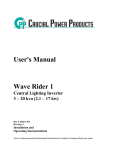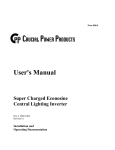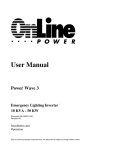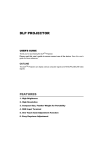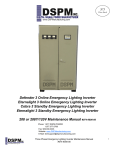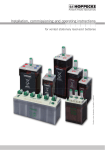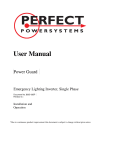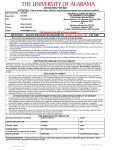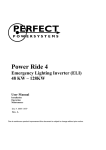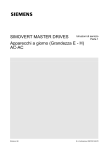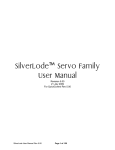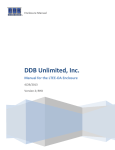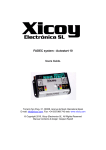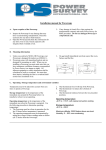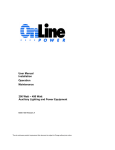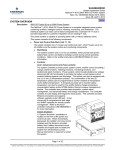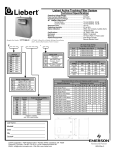Download User Manual Power Wave 1
Transcript
User Manual Power Wave 1 Central Lighting Inverter 3-20 KVA (2.1-17KW) Document No. 6002-1405 Revision M Installation and Operation Due to continuous product improvement this document is subject to change without prior notice. Online Power TABLE OF CONTENTS SECTION PAGE REVISION HISTORY c PROPRIETARY d SECTION 1 – SAFETY 1-1 SECTION 2 – OVERVIEW 2-1 2.1 2.2 2.3 2.4 2.5 2.6 2.7 INTRODUCTION Illustration 2.1 Power Wave 1 BENEFITS PRODUCT FEATURES Illustration 2.2: Unit Component Layout FUNCTIONAL DESCRIPTIONS Illustration 2.3: Functional Block Diagram THEORY OF OPERATION OUTPUT LOADS OPTIONS (See more detail on Section 4) SECTION 3 – OPERATION 3.1 3-2 3.3 3.4 3-1 START-UP PROCEDURES OPERATION FIELD REPLACEABLE UNITS Illustration 3-1: Heat Sink Assembly (FRU) RENEWAL PARTS SECTION 4 – SYSTEM OPTIONS 4.1 4.2 4.3 4.4 4.5 4.6 4.7 4.8 4.9 4.10 4.11 4.12 4.13 4.14 4.15 6002-1405 REV M 2-1 2-1 2-2 2-3 2-4 2-5 2-7 2-8 2-9 2-9 3-1 3-3 3-3 3-4 3-5 4-1 OPTIONAL EXTERNAL MANUAL BYPASS SWITCH Illustration 4-1: Manual Bypass Switch Illustration 4-2: Manual Bypass Switch Diagram OPTIONAL INTERNAL MANUAL BYPASS SWITCH OPTIONAL AUDIO ALARM WITH SILENCE SWITCH OPTIONAL REMOTE UNIT STATUS PANEL – P/N 9100-1020-06 Illustration 4-3: Remote Status Panel OPTIONAL FORM “C” CONTACTS FOR ALARMS – P/N 9100-1362-01 OPTIONAL TVSS – P/N 9100-1440-02 OPTIONAL NORMALLY ON / NORMALLY OFF OUTPUT AUX. CIRCUIT BREAKERS – P/N 9100-1343-01 THRU –16 OPTIONAL EXTERNAL OUTPUT AUX. CB’S IN PANEL BOARD – P/N 9100-1439-01 THRU –03 OPTIONAL HIGHER KAIC NORM ON/OFF OUTPUT CB OPTIONAL INPUT CB STANDARD / HIGHER KAIC OPTIONAL OUTPUT CB STANDARD / HIGHER KAIC OPTIONAL SEISMIC MOUNTING BRACKET – P/N 9100-1317-02 OPTIONAL STACKABLE CABINET RACK - P/N9100-1429-XX OPTIONAL POWER FLOW MIMIC – P/N 9100-1493-01 Illustration 4-4: Power Flow Mimic OPTIONAL GLOBAL MONITORING SYSTEM, Local on UPS a 4-2 4-2 4-3 4-4 4-4 4-5 4-5 4-6 4-6 4-7 4-7 4-7 4-7 4-8 4-8 4-8 4-8 4-8 4-9 Online Power SECTION PAGE 4.15.1 Local On UPS - Event Log – P/N 9100-1466-01/9100-1538-XX Illustration 4-5: Logged Events Illustration 4-6: Status Screen Illustration 4-7: System Info 4.15.2 Local On UPS - AUX CBs Trip Monitor with Event Log – P/N 9100-1453-01 Illustration 4-8: Auxiliary CB Trip 4.15.3 Local on PC via RS 232 Illustration 4-9: Sample PC Screen 4.15.4 Local on PC via RS 485 4.16 OPTIONAL ECC – Emergency Circuit Converter Illustration 4-10: ECC Emergency Circuit Converter 4.17 OPTIONAL ECM – Emergency Control Module Illustration 4-11: ECM Emergency Control Module SECTION 5 – MAINTENANCE 5.1 5.2 5.3 5.4 5.5 4-9 4-9 4-9 4-10 4-10 4-10 4-11 4-11 4-11 4-12 4-12 4-13 4-13 5-1 SAFETY PRECAUTIONS WHEN TO CALL STEPS TO TAKE PREVENTIVE MAINTENANCE ONLINE POWER CUSTOMER SERVICE AND SUPPORT 5-1 5-3 5-3 5-3 5-7 APPENDICES APPENDIX A – SPECIFICATIONS APPENDIX B – OPTIONAL MAIN INPUT/OUTPUT BREAKERS FOR VARIOUS MODELS APPENDIX C - BATTERY CONNECTIONS APPENDIX D - LCD DISPLAY MENU & TROUBLESHOOTING GUIDE APPENDIX E – DRAWINGS & TABLES, REQUEST FOR TURN ON APPENDIX F – CONNECTION DIAGRAM FOR EXISTING 3 POLE PANELBOARD SECTION 6 – INSTALLATION 6.1 6.2 6.3 6.4 6.5 6002-1405 REV M A-1 B-1 C-1 D-1 E-1 F-1 6-1 SITE PLANNING AND PREPARATION Illustration 6-1: 48” Cabinet Cable Access and Mounting Illustration 6-2: 68” Cabinet Cable Access and Mounting Illustration 6-3: Oversize Cabinet Cable Access and Mounting EQUIPMENT UNPACKING Illustration 6-4: Fork lifting UNIT INSTALLATION Illustration 6-5: Power Wave 1 Customer’s Connection Input Terminal Block Illustration 6-6: Customer’s Connection Terminal Block for 120/208/240/277V Output Illustration 6-7: Customer’s Connection Terminal Block for 208/240/277V Output Illustration 6-8: Customer Connections Same Input/Output Voltage, 120V Unit Illustration 6-9: Customer Connections Same Input/Output Voltage, 208V Unit Illustration 6-10: Customer Connections Same Input/Output Voltage, 240V Unit Illustration 6-11: Customer Connections Same Input/Output Voltage, 277V Unit Illustration 6-12: Customer Connections Output Connection w/Output XFMR, 120V Illustration 6-13: Customer Connections Output Connection w/Output XFMR, 208V Illustration 6-14: Customer Connections Output Connection w/Output XFMR, 240V Illustration 6-15: Customer Connections Output Connection w/Output XFMR, 277V Illustration 6-16: Customer Connections Dual Output Connection w/Output XFMR, 120/240V Illustration 6-17: Customer Connections Dual Output Connection w/Output XFMR, 120/208V Illustration 6-18: Customer Connections Dual Output Connection w/Output XFMR, 120/277V Illustration 6-19: Customer Connections Battery Connections REMOTE SIGNALLING CONNECTIONS (OPTIONAL) BATTERY STORAGE b 6-1 6-2 6-3 6-4 6-5 6-5 6-6 6-7 6-8 6-8 6-9 6-10 6-11 6-12 6-13 6-14 6-15 6-16 6-17 6-18 6-19 6-20 6-20 6-21 Online Power Online Power, Inc. Reproduction or Distribution forbidden NOTICE: THIS DOCUMENT CONTAINS PROPRIETARY INFORMATION This document contains proprietary and confidential information of Online Power, Inc. (”Online Power”). In consideration of the receipt of this document, the recipient agrees not to copy any of its contents, nor to disclose them to or allow them to be used by any person not currently an Online Power employee or an employee of the recipient having a need to know, without the express written consent of Online Power, and further agrees to surrender this document to Online Power when the reason for its receipt has terminated. © 2009 Online Power, Inc. – All rights reserved 6002-1405 REV M c Online Power Congratulations on selecting one of the fine products from Online Power, the leader in power protection technology. Our wide product offering includes UPS (Uninterruptible Power Systems), power conditioners, automatic voltage regulators and specialty transformers (e.g., computer-grade, medicalgrade). Since our founding in 1972, Online Power has shipped many of these fine products to discerning customers around the world for use on sensitive equipment and critical applications. One of our goals is to make our manuals both comprehensive and easy to use. The new format of our user manual is the result of ideas and inputs from customers like you who have taken an active interest in our continued success. We invite and appreciate your feedback on our products and documentation via e-mail, fax, mail, or telephone. SALES Phone: (800) 227-8899 FAX No: (323) 721-3929 E-mail: [email protected] Office Hours are 7:00 AM to 5:00 PM PST WARRANTY REGISTRATION AND WARRANTY CERTIFICATE REQUEST www.800pwrsrvc.com SERVICE If you require assistance, please call our 24-hour toll free hot line 800-PWR-SRVC (800-797-7782) or email to [email protected]. Please have the following information from your unit’s nameplate available to speed assistance: Serial Number: KVA/Power Rating: Input Voltage: Output Voltage: Manufacturer Date: 6002-1405 REV M d Online Power IMPORTANT SAFETY INSTRUCTIONS SAVE THESE INSTRUCTIONS SECTION 1 - SAFETY Following safety precautions is important when operating or servicing electrical equipment. The symbols shown are used extensively throughout this manual. Always heed these precautions since they are essential to the safe operation and servicing of this product. Boxes labeled with the “ Danger!” symbol indicate that there is a high risk of personal injury or death if instructions are not followed. Verify the Warnings labeled with the symbol indicate that there is a high probability of equipment failure, damage, or destruction if instructions are not followed. Danger! ONLY FACTORY TRAINED OR AUTHORIZED PERSONNEL SHOULD ATTEMPT TO INSTALL OR REPAIR THE UNIT OR ITS BATTERY SYSTEM. IMPROPER INSTALLATION HAS PROVEN TO BE THE SINGLE MOST SIGNIFICANT CAUSE OF START-UP PROBLEMS. HIGH AC AND DC ELECTRICAL VOLTAGES ARE PRESENT THROUGHOUT THE UNIT(S) AND INCORRECT INSTALLATION OR SERVICING COULD RESULT IN ELECTROCUTION, FIRE, EXPLOSION, OR EQUIPMENT FAILURE. Danger! READ THIS MANUAL IN ITS ENTIRETY BEFORE PERFORMING THE INSTALLATION, START-UP, OPERATION, OR MAINTENANCE OF THE UNIT (Uninterruptible Power System) OR BATTERY SYSTEMS. FAILURE TO DO SO COULD RESULT IN ELECTROCUTION, FIRE, EXPLOSION, OR EQUIPMENT FAILURE. If you require assistance, call toll free 800-PWR-SRVC (800-797-7782). Please have the following information from your unit’s nameplate available to speed assistance: Serial Number: kVA/Power Rating: Input Voltage: Output Voltage: Manufacturer Date: 6002-1405 REV M 1-1 Online Power Danger! ALL POWER CONNECTIONS MUST BE COMPLETED BY A LICENSED ELECTRICIAN WHO IS EXPERIENCED IN WIRING THIS TYPE OF EQUIPMENT. WIRING MUST BE INSTALLED IN ACCORDANCE WITH ALL APPLICABLE NATIONAL AND LOCAL ELECTRICAL CODES. IMPROPER WIRING MAY CAUSE DAMAGE TO THE EQUIPMENTS, INJURY OR DEATH OF PERSONNEL. VERIFY THAT ALL HIGH AND LOW VOLTAGE INPUT POWER CIRCUITS ARE DE-ENERGIZED AND LOCKED OUT BEFORE INSTALLING CABLES OR MAKING ANY ELECTRICAL CONNECTIONS. Danger! EXERCISE EXTREME CARE WHEN HANDLING UNIT AND BATTERY CABINETS TO AVOID EQUIPMENT DAMAGE OR INJURY TO PERSONNEL. CABINETS WEIGH SEVERAL HUNDRED POUNDS. Danger! TEST LIFT AND BALANCE THE CABINETS BEFORE MOVING. MAINTAIN MINIMUM TILT FROM VERTICAL AT ALL TIMES. THE BOTTOM STRUCTURE WILL SUPPORT THE UNIT ONLY IF THE FORKLIFT FORKS ARE COMPLETELY UNDERNEATH THE UNIT. Danger! OBSERVE ALL BATTERY SAFETY PRECAUTIONS DURING INSTALLATION OR SERVICE OF THE UNIT OR BATTERIES. EVEN WITH THE BATTERY CIRCUIT BREAKER IN THE OFF POSITION, THE DANGER OF ELECTROCUTION MAY STILL BE PRESENT. THE BATTERY POWER TO THE UNIT MUST BE LOCKED AND TAGGED “OFF” BEFORE PERFORMING ANY SERVICE OR WORK ON THE UNIT. THE BATTERY MANUFACTURER’S SAFETY INFORMATION AND MATERIAL SAFETY DATA SHEET IS LOCATED IN A POCKET ATTACHED TO THE INSIDE OF LEFT DOOR OF EACH UNIT. FAILURE TO FOLLOW THOSE INSTRUCTIONS AND THE INSTRUCTION LISTED ABOVE AND ELSEWHERE IN THIS MANUAL COULD RESULT IN AN EXPLOSION, FIRE, EQUIPMENT FAILURE, OR ELECTROCUTION. 6002-1405 REV M 1-2 Online Power Danger! ALL POWER TO THE UNIT MUST BE LOCKED AND TAGGED “OFF” BEFORE PERFORMING ANY SERVICE OR WORK ON THE UNIT. FAILURE TO DO SO COULD RESULT IN ELECTROCUTION. Danger! IN CASE OF FIRE INVOLVING ELECTRICAL EQUIPMENT. ONLY CARBON DIOXIDE FIRE EXTINGUISHERS, OR THOSE APPROVED FOR USE ON ELECTRICAL EQUIPMENT, SHOULD BE USED. USE OF WATER ON FIRES INVOLVING LIVE HIGH VOLTAGE ELECTRICAL CIRCUITS COULD PRESENT AN ELECTROCUTION HAZARD. Danger! EXTREME CAUTION IS REQUIRED WHEN PERFORMING MAINTENANCE. LETHAL VOLTAGES EXIST WITHIN THE EQUIPMENT DURING OPERATION. OBSERVE ALL WARNINGS AND CAUTIONS IN THIS MANUAL. FAILURE TO COMPLY MAY RESULT IN SERIOUS INJURY OR DEATH. OBTAIN QUALIFIED SERVICE FOR THIS EQUIPMENT AS INSTRUCTED. Danger! BE CONSTANTLY AWARE THAT THE UNIT SYSTEM CONTAINS HIGH DC AS WELL AS AC VOLTAGES. WITH INPUT POWER OFF AND THE BATTERY, DISCONNECTED, HIGH VOLTAGE AT THE FILTER CAPACITORS AND POWER CIRCUITS SHOULD DISCHARGE WITHIN 30 SECONDS. HOWEVER, POWER CIRCUIT FAILURES CAN OCCUR, SO YOU SHOULD ALWAYS ASSUME THAT HIGH VOLTAGE MIGHT STILL EXIST AFTER SHUTDOWN. VERIFY THAT POWER IS OFF USING AC AND DC VOLTMETERS BEFORE MAKING CONTACT. Danger! SOME COMPONENTS WITHIN THE CABINETS ARE NOT CONNECTED TO CHASSIS GROUND. ANY CONTACT BETWEEN FLOATING CIRCUITS AND THE CHASSIS IS A LETHAL SHOCK HAZARD. 6002-1405 REV M 1-3 Online Power Danger! INTERNAL BATTERY STRAPPING MUST BE VERIFIED BY THE CUSTOMER PRIOR TO MOVING THIS UNIT. THIS UNIT CONTAINS NON-SPILLABLE BATTERIES. KEEP THE UNIT UPRIGHT. DO NOT STACK. DO NOT TIP. ALWAYS FOLLOW THE BATTERY MANUFACTURER’S SAFETY INFORMATION LOCATED IN A POCKET ATTACHED TO THE INSIDE OF THE LEFT DOOR OF YOUR UNIT TO PREVENT AN ACCIDENT THAT COULD RESULT IN INJURY OR DEATH. Danger! LEAD-ACID BATTERIES CONTAIN HAZARDOUS MATERIALS. BATTERIES MUST BE HANDLED, TRANSPORTED, AND RECYCLED OR DISCARDED IN ACCORDANCE WITH FEDERAL, STATE, AND LOCAL REGULATIONS. BECAUSE LEAD IS A TOXIC SUBSTANCE, LEAD-ACID BATTERIES SHOULD BE RECYCLED RATHER THAN DISCARDED. DO NOT DISPOSE OF BATTERIES IN A FIRE, THE BATTERIES MAY EXPLODE. DO NOT OPEN OR MUTILATE THE BATTERIES. RELEASED ELECTROLYTE IS HARMFUL TO THE SKIN AND EYES AND MAY BE TOXIC. A BATTERY CAN HAVE A HIGH SHORT CIRCUIT CURRENT AND PRESENT A RISK OF ELECTRICAL SHOCK. THE FOLLOWING PRECAUTIONS SHOULD BE OBSERVED WHEN WORKING ON BATTERIES: 1. 2. 3. 4. 5. 6 7 8 6002-1405 REV M REMOVE WATCHES, RINGS OR OTHER METAL OBJECTS. USE TOOLS WITH INSULATED HANDLES. WEAR RUBBER GLOVES AND BOOTS. DO NOT LAY TOOLS OR METAL PARTS ON TOP OF BATTERIES. DISCONNECT CHARGING SOURCE PRIOR TO CONNECTING OR DISCONNECTING BATTERY TERMINALS. DETERMINE IF BATTERY IS INADVERTENTLY GROUNDED. IF SO, REMOVE THE SOURCE OF THE GROUND. CONTACT WITH ANY PART OF A GROUNDED BATTERY CAN RESULT IN ELECTRICAL SHOCK. THE LIKELIHOOD OF SUCH SHOCK WILL BE REDUCED IF SUCH GROUNDS ARE REMOVED DURING INSTALLATION AND MAINTENANCE. LEAD-ACID BATTERIES CAN PRESENT A RISK OF FIRE BECAUSE THEY GENERATE HYDROGEN GAS. THE FOLLOWING PROCEDURES SHOULD BE FOLLOWED: 1. DO NOT SMOKE WHEN NEAR BATTERIES. 2. DO NOT CAUSE FLAME OR SPARK IN BATTERY AREA. DISCHARGE STATIC ELECTRICITY FROM YOUR BODY BEFORE TOUCHING BATTERIES BY FIRST TOUCHING A GROUNDED SURFACE. 1-4 Online Power SECTION 2 – OVERVIEW 2.1 INTRODUCTION The Power Wave 1 Central Lighting Inverters are manufactured to provide critical power for lighting during a power outage. The Power Wave 1 meets or exceeds the life safety codes of UL924 and UL1778. These codes were established to allow the emergency lighting inverters to provide critical power to the lighting circuits during a power failure. The emergency lighting inverter will then provide power for 90 minutes that will allow safe and orderly evacuation from the facility. When input power to the Power Wave 1 is lost during a power outage, the system will automatically draw power from its internal battery supply without any interruption. The critical load will receive only clean sine wave power. The optional output transformer allows multiple output voltages as well as input voltages that are different than output voltages. The internal VRLA (valve regulated lead-acid), maintenance-free batteries provide 90 minutes of backup power. Upon restoration of input power, the Power Wave 1 automatically resumes normal operation, and immediately begins to recharge the batteries. The Power Wave 1 has an internal bypass circuit, which maintains the power to the load in case of internal unit failure. The Power Wave 1 provides comprehensive monitoring capabilities. In addition to the LCD display, it provides five dry relay contacts for remote monitoring capabilities. Power Wave 1 contains, as standard features, an AS 400, RS 232 protocol interface, RS485 data transmission ports and many other communication options. The Power Wave 1 is an on-line single phase PWM inverter available in output rating of 3, 5, 7.5, 12.5, 15, 20 kVA, and 3, 5, 7.5, 12.5, 15,17 KW. The Power Wave 1 is listed for compliance to UL1778, UL924, UL924A and CSA107.1 standards. The Power Wave 1 is available with an input or output voltages of 120, 208, 240, or 277 VAC, single phase. This information is provided on the nameplate located on the inside front door of the unit. See Appendix A for a complete listing of the Power Wave 1 specifications. 68” High Cabinet 48” High Cabinet ILLUSTRATION 2-1: POWER WAVE 1 6002-1405 REV M 2-1 Online Power 2.2 BENEFITS Electrical disturbances can come from practically anywhere: from the incoming power lines and even from within a building. Outside electrical disturbances include lightning strikes, utility switching, brown-outs, and accidents. Electrical disturbances in a facility can be caused by load cycling (elevators, HVAC systems, etc.), fault conditions, welders, and other electrically noisy equipment. Whether the electrical disturbances are generated outside or within the facility, the following power problems can occur: Complete power outages; Brown-outs including momentary sags; Voltage surges; Transients including common-mode and transverse-mode noise; Frequency shifts and fluctuations. Sensitive equipment needs protection from power problems. Without power protection, users of sensitive equipment may experience: Loss of data; Database corruption; Rebuilding of files; Equipment and component deterioration; Premature equipment failures; Unexpected equipment malfunctions; Missed deadlines, especially during batch processing; Loss of real time transaction processing; Loss of employee productivity The Power Wave 1 is a self-contained unit a simple solution for back-up power for any fluorescent or incandescent lighting source such as overhead fixtures, exit signs, etc. It has been specifically designed to maintain 90 minutes of lighting power and ensure a safe building evacuation. It offers significant advantages over other alternatives. For example, just one Power Wave 1 Central Lighting Inverter can replace 70 "bug eyes" to make service and maintenance much quicker and easier. The convection cooled, OnLine PWM inverter system, is virtually silent and can be installed anywhere. On-line PWM technology provides switchover from utility to battery power without any interruption. The Power Wave 1 is designed to fit the needs of virtually all power conditioning and unit applications. It has been designed to power all forms of modern data processing, communication, and process control equipment. The Power Wave 1 does not require any de-rating, as other products may, when powering 100% electronic loads including switching mode power supplies. The Power Wave 1protects sensitive electrical equipment, such as computer servers, telecommunication networks, LANs, multi-user, and instrumentation systems from electrical interference including problems associated with poor quality AC power sags and complete power outages. 6002-1405 REV M 2-2 Online Power 2.3 PRODUCT FEATURES The following describes the major blocks within the Power Wave 1. Please refer to Illustration 2-2, System Component Layout to find specific items. 2.3.1 Input Contactor K1 (Illustration 2-2, Item 12) The input contactor is multifunctional. First, it provides connections for the input power to the unit. Secondly, the contactor disconnects the input line when an outage occurs so that there is no back feeding of power into the power line. Finally, the contactor allows for automatic unit operation upon a complete discharge of the batteries. No operator intervention is required when power to the unit is restored after a complete battery discharge. 2.3.2 Battery Charger The battery charger maintains the batteries at full charge. After a battery discharge, the charger will automatically recharge the batteries upon restoration of input power. This circuit is on the Power Board. 2.3.3 Power Board Assembly with IGBT’s (Illustration 2.2, Item 1) The Power Board is bolted onto the IGBT (Insulated Gate Bipolar Transistor) blocks that are mounted on a heat sink. The complete Heat Sink Assembly with IGBTs and Power Board is replaceable as a single part. This FRU (Field Replaceable Assembly) converts all the power, i.e. input AC power converted to DC bus, battery power boosted to DC bus, and finally DC bus power converted to output AC power using PWM technology for a smooth AC sine wave. In case of a catastrophic failure, the complete Heat Sink Assembly is easily replaceable using only a screwdriver. The Power Board also contains the housekeeping power supplies and drivers for the IGBTs. The entire assembly provides the landing place for all internal input, output, DC cables and metering devices for control and monitoring of the unit input and output currents. 2.3.4 Control Board (Illustration 2.2, Item 10) The microprocessor with unit specific firmware and control circuitry is located on the Control Board. The Control Board is mounted on the cabinet door and communicates with the Power Board (A2) via a ribbon cable. It monitors the input and output voltages and generates the command to close or open the input contactor and to sense and change the status of the bypass static switch. The Control Board sends data to the LCD panel located on the door where actual status and parameters are displayed. It additionally has AS400, RS232, and RS485 output capabilities and supports various communication including SNMP options. 2.3.5 Output Static Switch (Illustration 2.2, Item 3) This SCR solid-state switch connects the output of the inverter (UPS) to the load. It is connected on the primary side of the optional output isolation transformer. This switch shuts off in case of a problem or failure within the unit and transfers the load directly to the utility input via the bypass static switch. It maintains it’s status opposite to that of bypass switch. 2.3.6 LCD Display Panel (Illustration 2.2, Item 11) The LCD (Liquid Crystal Display) panel provides all the input, output, battery metering and alarm data, and UPS status for customer use on a constantly scrolling set of 2 default screens with continuous update. 6002-1405 REV M 2-3 Online Power 2.3.7 Optional Output Isolation Transformer (Illustration 2.2, Item 20) The output isolation transformer provides isolation between the inverter and protected output. The power to the primary of this transformer is received from unit and is transformed to required output voltage levels. It will also add another screen to the main menu. 2.3.8 Optional Maintenance Bypass Switch (Illustration 2.2, Item 2) The MBS (Maintenance Bypass Switch) removes the critical load from the backup power and providing utility input directly to the load in case of a malfunction of the unit or during system maintenance. 2.3.9 Battery Bank (Illustration 2.2, Item 26) The battery bank consists of sealed, maintenance-free batteries. The batteries provide emergency power during power outages. The battery bank includes a breaker for over current protection and DC disconnect. 2.3.10 System Component Layout) 19 7 9 8 13 14 1 15 28 17 16 1) 2) 3) 4) 19 10 C1 C3 C2 12 5 11 6 1 2 3 1 2 3 4 5 6 7 1 2 3 4 27 21 3 18 20 2 25 24 26 23 22 ILLUSTRATION 2-2: COMPONENT LAYOUT 6002-1405 REV M 2-4 Power Board (A1) Bypass Static Switch (PB1) Output Static Switch (PB2) Input/Output/Battery Terminal Block for customer’s use (TB1, TB2, TB3) 5) Input Choke (L2) 6) Output Choke (L3) 7) DC Choke (L4) 8) Input Choke (L1) 9) High Frequency Noise Filter Capacitors for Input (C1), Output (C2), and Battery (C3) Power 10) Control Board (A2) 11) LCD Display Board 12) Input Contactor (K1) 13) Terminal Block to remove heat sink assembly (TB4) 14) Fan Transformer (T3) 15) Control Power Transformer (T2) 16) Control Transformer Fuse (F1) 17) Fan Fuse (F2) 18) Heat Sink 19) Fan(s) 20) Optional Output Isolation Transformer (T1) 21) Breaker Panel 22) Input Breaker (CB2) 23) Battery Breaker (CB1) 24) Output Breaker (CB3) 25) Output Distribution Breakers (CB4 and on) 26) Maintenance Free Lead Acit Battery(s) 27) Inverter Test Switch (S2) 28) Rectifier Block (BR1) Online Power 2.4 FUNCTIONAL DESCRIPTION Illustrations 2-3 depict FUNCTIONAL block diagrams of the Power Wave 1. These diagrams provide an excellent tool for identifying the major building blocks within the Power Wave 1. 2.4.1 Main input circuit breaker - optional The main input circuit breaker provides Power Wave 1 with incoming power isolation and input overcurrent protection. 2.4.2 Input Contactor Input contactor controls power applied to the unit. The microprocessor control circuit verifies that the unit is in "normal" and not at a "fault" condition and that the input voltage and frequency are within an acceptable range. Only then it energizes the contactor closing coil via control transformer and fuse. 2.4.3 Input Inductors The input inductors are a single phase input filter. 2.4.4 Inverter When the AC input power is not available to power the load, the inverter converts the energy stored in the battery bank to AC power to supply power to the load. The pulse width modulated (PWM) inverter utilizes high speed, high efficiency IGBT’s for fast response, sinusoidal power. 2.4.5 Battery charger The battery charger converts AC power into regulated DC power to re-charge and to maintain the charge on the battery bank. The charger is fully automatic with a current limiting feature so that battery damage will be prevented in case of a charger malfunction. The charger is sized such that the batteries will be maintained at full charge even when the input voltage is at the low line limit for indefinite periods of time. 2.4.6 Battery The battery bank, shall consist of 8, 10, 16, 20, or 32, 12 Volt batteries, providing the reserve energy to sustain the load when suitable AC input power is not present. The batteries are sealed, maintenance-free, VRLA (Valve Regulated Lead Acid) construction. 2.4.7 DC Choke The DC choke helps boost battery voltage to a higher internal DC bus voltage while it reduces high frequency noise. 2.4.8 Output Transformer (used only for multiple output voltage units) The Output transformer performs two critical functions. First, it provides excellent common mode and normal mode noise isolation of the load from the input or inverter power. Secondly, it provides voltage transformation and tight regulation of the output voltage while the Power Wave is operating from its internal inverter and it can be utilize to provide a different voltage than input (source voltage). 2.4.9 Inverter Test Switch The SW-2 test momentary switch is a push button switch for testing the Power Wave 1 and the batteries for proper operation. When the Power Wave 1 is running and Switch SW-2 is pushed and held in, the Power Wave 1 will automatically transfer to battery operation. The Power Wave 1 will continue to run on batteries until the switch is released. When the switch is released, the Power Wave 1 returns to normal operation (provided input power is present). 6002-1405 REV M 2-5 Online Power 2.4.10 Power Supply Transformer This transformer with fuse (F1), provides internal housekeeping DC power supply. The primary of this transformer has taps to match with the input voltage. 2.4.11 Control Transformer (T2) Transformer with 120 VAC secondary for control of the K1 contactor coil from the A1 control board. 2.4.12 Maintenance Bypass Switch This Maintenance Bypass Switch (MBS) allows the Power Wave 1 to be switched off line for maintenance or troubleshooting when the inverter malfunctions or PM (Periodic Maintenance) is required. The MBS transfers the input power directly to critical load without any break or power disruption. Before switching the MBS to the maintenance position, turn on toggle switch S1 if unit is so equipped, and then rotate the maintenance bypass switch to the maintenance (MAN) position. Refer to the operation label on the unit. After repair or periodic maintenance, the MBS must be switched to UPS position, in cases where the toggle switch has been incorporated with the switch, be sure not to leave the switch in the middle position as this will not provide any output power when the unit is off. Caution! STOPPING ROTATION OF THE MAINTENANCE BYPASS SWITCH BETWEEN POSITIONS WILL RESULT IN THE REMOVAL OF OUTPUT VOLTAGE. 2.4.13 Fan Transformer The Fan transformer provides 120 VAC to the fans(s) with taps to match unit output voltages. Fuse F2 protects fans & transformer. 2.4.14 Efficiency Optimizer Function: (OFF Line Inverter Mode) When Input Power is available, the batteries shall be charged and AC output from inverter thru inverter static switch supports to the critical load. In this Normal Mode Operation, the inverter static switch is closed and bypass static switch is opened. The bypass static switch is closed only upon inverter faults or upon manual operation and then output power thru bypass static switch supports critical load. This is normal operation for true-double convention UPS. However there is demand for higher efficiency UPS in industry to reduce cost of electricity and want to use as “off-line inverter” which means that normal operating mode is reversed such that bypass static switch is closed normally as long as input voltage and input frequency are within ±10% permissible windows of normal voltage and ±3hz of normal frequencies and inverter static switch is opened. The inverter static switch is only closed upon the failure of input power or upon out of voltage and frequency normal ranges. This is called the “off line inverter mode” and system efficiency is higher as 98% and reduces the total power loss. The output AC voltage in the mode of operation follows proportionally to the input line voltage. In another words, there is no output voltage regulation within ±10% window voltage range or ± 15% (selectable) window voltage range. There are two versions, one is fast transferring with a quarter of cycle (2.5 milli-second), another is slow transferring with 25 cycles (400 milli-second second to 1second).Fast transferring time is required when the loads are sensitive to voltages such as HID lights and other that any voltage disturbance effects their operation. One must consider that higher efficiency of unit is only requirement and output voltage regulation is not critical as much. Option part numbers refer to 4.18 options AC off-line inverter operation with 2 version of transferring time. 6002-1405 REV M 2-6 Online Power ILLUSTRATION 2-3: FUNCTIONAL BLOCK DIAGRAM 6002-1405 REV M 2-7 Online Power 2.5 THEORY OF OPERATION 2.5.1 Standby Mode After power is applied, the system is placed in STANDBY mode and a self-check starts. During this period, the start subroutine checks for the input voltage and proper operation of the inverter and bypass SCR’s. After the routine is completed and check confirmed OK, the system goes into the NORMAL mode. 2.5.2 Normal Mode The input contactor K1 receives a closing signal, connecting input power to the DC supply transformer. The DC rectifier supplies the battery charger, Control Board and the DC/AC inverter circuit. The battery charger is then activated allowing the batteries to be continuously charged. The on-line DC/AC inverter converts the DC voltage to a pulse-width-modulation (PWM) waveform. This waveform is filtered and reconstructed back to a desired AC output. 2.5.3 Response To Input Power Failure If the system controller senses a change in input frequency of more than +3 Hz or an out of range input voltage, it will consider it an input failure and will immediately open the input contactor, isolating the unit from the facility. At the same time, the charger is turned off and the battery bank becomes a DC supply source to the inverter circuit, maintaining an uninterrupted AC supply to the protected load. The LCD screen will display a ”UPS ALARM” message. When the facility power returns, stabilizes and is in phase with the backup power, the system controller closes the input contactor and the system returns to NORMAL. If the battery voltage drops below 16% of its nominal value and the facility power remains off, then the system will assume a ALERT mode. 2.5.4 UPS ALERT The System controller will issue a ALERT message on the LCD screen if any of the following conditions happen: Internal failure System overheats Battery bank undervoltage During a ALERT, the system stops its backup operation, inverter SCRs are switched OFF, and bypass SCRs are switched ON. A summary alarm 5V signal is sent to the hardwired interface. The system remains in this mode until power is cycled or system has been repaired when needed. 2.5.5 UPS ALARM The System controller will issue a UPS ALARM message on the LCD screen if any of the following conditions occur: Input power failure Output overload During a ALARM mode, inverter IGBs remain on and an alarm signal may be sent to the signal interface. The system will reset itself as soon as the problems disappear. 6002-1405 REV M 2-8 Online Power 2.6 OUTPUT LOADS The Power Wave 1 is designed to power any fluorescent or incandescent and HID lighting. There are, however, certain types of loads that exhibit an excessive inrush current when first turned on or at other times during operation. The capacity of the Power Wave 1 may need to be greater than what would be estimated based on the nameplate requirements of loads previously discussed. Contact your Online Power dealer or the factory directly if you have any questions about powering unusual loads from your Power Wave 1. 2.7 OPTIONS (See Section 4 for details) The following options are available with the Power Wave 1: Internal / External Manual Bypass Switch Audio Alarms with Silence Switch Remote UPS Status Display, 1 phase Monitor Form “C” N/O Contacts for Alarms TVSS (Transient Voltage Surge Suppressor) Normally ON/OFF Output Aux. Circuit Breakers External Output Aux. Circuit Breakers in Panel Board Stackable Cabinet Rack System Input CB Standard/Higher KAIC System Output CB Standard/Higher KAIC Higher KAIC Norm .ON/OFF Output Circuit Breaker, Molded case Higher KAIC Norm. ON/OFF Output Circuit Breaker 1 Phase. Din rail Seismic Mounting Bracket (Left and Right set per cabinet) Power Flow Mimic GMS (Global Monitoring System) • Local via PC with RS232 • Local via PC with RS485 • Basic NetAgent SNMP • Basic NetAgent SNMP with WIFI HUB application • Advanced NetAgent SNMP • Advanced NetAgent SNMP with WIFI HUB. • Advanced NetAgent SNMP with GPRS mobile modem. • Advanced NetAgent SNMP with dial-up modem ECC – Emergency Circuit Converter ECM – Emergency Control Module 6002-1405 REV M 2-9 Online Power SECTION 3 – OPERATION 3.1 START-UP PROCEDURES The unit's batteries are shipped directly from battery the manufacturer to insure brand new batteries and allow an opportunity for the installing contractor to schedule their arrival when they are ready to commission the system. The battery cabinet and the interconnect cables are shipped with the electronics section of the inverter in a cardboard box located inside each battery cabinet. OnLine Power service personnel must perform initial start-up or a factory trained authorized representative. To request start-up, fax a completed Request Turn-On form (6002-1545) to 323-721-3929 or e-mail it to [email protected]. Form is now available in the web at www.800pwrsrvc.com. The start-up procedure described in this manual is a reference only to a start up of the Power Wave 1 for maintenance and shutdown. Please be sure not to start up the unit without the assistance of a factory trained, authorize personal as failure to do so may damage the unit and void the unit warrantee. 3.1.1 Verify that the main input circuit breaker, battery breaker, and output circuit breaker(s), are in the ”OFF” or ”down” positions. Refer to illustration 2-2 for the location of the circuit breakers. 3.1.2 Check all cable connections are firmly secured. Caution Caution If during the start-up procedures anything unusual occurs, immediately turn off the input circuit breaker, and contact Online Power at (800) 7977782 for technical assistance. Also, use this number for any other questions or additional information. The main input power and reserve input power should be available at same time when dual input power sources are used. 3.1.3 Apply input power to the Power Wave 1 Input Circuit Breaker remains open. Verify that the voltage measured on the input circuit breaker is 120/208/240/ or 277 VAC and is the same as nameplate voltage rating. If the voltage is not the same as on nameplate within +15% to -10% tolerance, do not proceed any further. Contact Online Power at (800) 797-7782 for technical assistance. Verify that there are no voltages measured on the output terminal block. 3.1.4 Turn on the main input circuit breaker. 3.1.5 After turning on the system, wait one (1) minute while the Power Wave 1runs through its internal diagnostic routines. Hear the sound of contactor closing. See the fan(s) running. See the LCD display screen showing UPS Normal message. 6002-1405 REV M 3-1 Online Power Line 1 Line 2 Line 3 Line 4 UPS NORMAL @ XX kVA INPUT OK @ CHRG ON BATTERY OK @ DC OK ON INVERTER @ OUT OK Verify that the LCD display panel indicates all correct parameters - see Appendix D for details. Verify that the output voltage is 120/208/240/277 VAC per the nameplate. 3.1.6 Close battery breaker in the unit cabinet [and in battery cabinet(s)]. 3.1.7 At this time, the Power Wave 1 should be providing AC line power. If the Power Wave 1 is not operating in the normal mode, turn off the input circuit breaker. Contact Online Power at (800) 797-7782 for technical assistance. 3.1.8 Recheck that the output voltage is 120/208/240/ or 277 VAC. If the output voltage is approximately the same as the nameplate, turn on the loads. 3.1.9 Verify battery operation and the inverter test switch. To place the Power Wave 1 in battery operation (simulate loss of input power), press and hold yellow Inverter Test Push Button. With Push Button in the hold position, the Power Wave 1 should be running on its internal batteries. Verify that the LCD panel displays is as below, where “xx” is the kVA of this unit: Line 1 Line 2 Line 3 Line 4 UPS ALARM INPUT BAD BATTERY OK ON INVERTER @ @ @ @ XX kVA CHRGR OFF DC OK OUT OK Release the yellow Inverter Push Button and Verify that the LCD PANEL displays “INPUT OK @ CHRGR ON”. Caution Be sure to release the Push Button, after the test, so it will not deplete the batteries. 3.1.10 The Power Wave 1 is now fully functional - providing clean, sine wave power to the load with battery back-up in case of an input power failure. This concludes the start-up procedures. 6002-1405 REV M 3-2 Online Power 3.2 OPERATION 3.2.1 Turning On the Power Wave 1 1 Apply input power. 2. With input power available, turn on the main input circuit breaker. 3. Wait until you hear the input contactor closing and fan running. 4. Close the battery circuit breaker, only after the LCD display is lit and displays screens per Appendix D. 5. Verify that all parameters on the LCD display panel are proper. See Appendix D for display details. 6. Close the output circuit breaker. 7. Turn On the auxiliary output circuit breakers. 3.2.2 Turning Off the Power Wave 1 Turn off the Output Breaker(s), Battery Breaker, and Input Breaker. 3.3 FIELD REPLACEABLE UNITS (FRUS) Refer to Table 3-1 for ordering the replacement parts from the factory. Supply the information from the unit's nameplate, including the serial number, model number, kVA, P.F., input/output battery voltages, and date of manufacture, when ordering parts from factory. Call Toll Free (800) PWR-SRVC in North America. Replacement parts must be replaced by qualified factory trained service personnel only. 3.3.1 Control Board This Control Board is located on the inside right door at the top and mounted at 4 corners with screws and washers. Verify that all connectors are matches with their designations and pins #1, 2, etc. Unplug P1 through P15. Install the new board. Reconnect all plugs and connections maintain them with their original orientations. 3.3.2 All Other Parts Verify that the cables are marked before disconnecting. Replace the defective part with the new part. Reconnect wiring the same way as it was disconnected. 6002-1405 REV M 3-3 Online Power 3.3.3 Heat Sink Assembly Replacement Procedure 1) Disconnect and isolate all sources of power. 2) The Heat Sink Assembly is located on the right side of the top electronic shelf, inside the unit cabinet (Illustration 3-1). Verify that all cables and connectors have labels and are identified as shown. This is important for reinstalling the assembly. 3) Disconnect connectors P7, P6, P4, P1 from the PCB, A1, which is mounted horizontally on the big black heat sink. 4) Disconnect 5 power cables at TB4-1 through TB4-5 using flat screw driver. Verify and install label ID for each cable before disconnecting. 5) Loosen 3 Phillips head screws at front holding heat sink bracket. Pull the complete assembly forward and up. Remove it from tray gently, making sure that no cables or wires are catching (See illustration 3-1). 6) Install new assembly in the reverse order. Note that the rear bracket attached to the heat sink slides under the bracket secured on to the back panel. Slide the assembly back and reinstall 3 Phillips screws. 7) Reinstall all the cables and connectors in the reverse order. Verify per illustration 3-1. 8) Verify connections prior to starting up the unit. Phase C (Q3/Q4) TB4 Phase A (Q1/Q2) Phase B (Q5/Q6) E2 (Q7/Q8) E1/C2 (Q7/Q8) A3-P1 (WHITE) A3-P1 (RED) P1 P7 PB2-1 1 2 PB2-2 P4 PB1-2 PB1-1 A4-P1 (RED) P6 A4-P1 (WHITE) 3-4 BLK RED J4 1 2 J6 1 2 3 4 ILLUSTRATION 3-1: HEAT SINK ASSEMBLY (FRU) 6002-1405 REV M BLK RED J7 Online Power 3.4 RENEWAL PARTS Table 3-1: System Parts ITEM QTY 1 1 Power Board 2 1 Bypass Static Switch PB2 3 1 Output Static Switch PB1 4 1 Input/Output/Battery Terminal Block for customer’s use 5 1 Input Choke 6 1 Output Choke L2 7 1 DC Choke L4 8 1 The Frequency Noise Filter Capacitors for output Power 9 1 Control Board A2 10 1 LCD Display Board A5 11 1 Input Contactor 12 1 Terminal Block to remove heat sink assembly 13 1 Fan Transformer T3 14 1 Control Power Transformer T2 15 1 Control Transformer Fuse F1 16 1 Fan Fuse 17 1 Heat Sink Assembly 18 1 Fan(s) 19 1 Optional Output Isolation Transformer 20 1 Input Breaker CB2 21 1 Battery Breaker CB1 22 1 Output Breaker 23 1 Output Distribution Breaker 24 6002-1405 REV M DESCRIPTION DESIGN A1 TB1, TB2, TB3 L1, L3 C1, C2, C3 K1 TB4 F2 HS1 B1 thru B5 T1 CB3 8, 10, 16, 20 Maintenance Free Lead Acid Battery(s) 3-5 CB4 and Up B1 and Up Online Power SECTION 4 – SYSTEM OPTIONS This section describes options available with the Power Wave 1 phase. The following are available: Part Number Options 3000-044 thru -056 External Manual Bypass Switch 9100-1359-01 thru -04 Internal Manual Bypass Switch 9100-1363-01 Audio Alarms with Silence Switch 9100-1020-06 Remote UNIT Status Display 9100-1362-01 Form “C” N/O Contacts for Alarms 9100-1401-02, -12, -13 TVSS (Transient Voltage Surge Suppressor) 9100-1343-01 thru -16 Normally ON/OFF Output Aux. Circuit Breakers 9100-1439-01 thru -03 External Output Aux. Circuit Breakers in Panel Board 9100-1429-xx Stackable Rack (1 rack per 2 cabinets) N/A System Input CB Standard/Higher KAIC N/A System Output CB Standard/Higher KAIC 9100-1434-31 thru 86 Higher KAIC Norm .ON/OFF Output Circuit Breaker, Molded case (208/240) 9100-1435-01-26, 61-86 Higher KAIC Norm. ON/OFF Output Circuit Breaker 1 Phase. Din rail (277V) 9100-1317-02 Seismic Mounting Bracket (Left and Right set per cabinet) 9100-1493-01 Power Flow Mimic GMS (Global Monitoring System) 9800-005-xx Local on PC - via RS232 9800-006-01 Local on PC - via RS485 9800-007-01 Basic NetAgent SNMP 9800-007-02 Basic NetAgent SNMP with WIFI HUB 9800-008-01 Advanced NetAgent SNMP 9800-008-02 Advanced NetAgent SNMP with WIFI HUB 9800-008-03 Advanced NetAgent SNMP with mobile GPRS modem 9800-008-04 Advanced NetAgent SNMP with Dial-up modem 9100-1501 ECC – EMERGENCY CIRCUIT CONVERTER 9100-1502 ECM – EMERGENCY CONTROL MODULE 6002-1405 REV. M 4-1 Online Power 4.1 Optional External Maintenance Bypass Switch – P/N 3000-044 thru -056 PART NO. ENCLOSURE SIZE “INCH” AMP W H D W1 H1 3000-044 55 AMP 14 16 8 *12 *16.75 3000-045 110 AMP 14 16 10 *12 *16.75 ENCLOSURE DIM’S SELECTION CHART FOR SINGLE PHASE UPS KW/KVA 3 KW/KVA 5 KW/KVA 7.5 KW/KVA 10 KW/KVA 15 KVA/KW 20/17 FOR WIRING DIAGRAM SEE DWG 3000-045 3000-044 3000-044 3000-045 3000-045 3000-045 6001-032-31S ILLUSTRATION 4-1: EXTERNAL MAINTENANCE BYPASS SWITCH 6002-1405 REV. M 4-2 Online Power ILLUSTRATION 4-2: MAINTENANCE BYPASS SWITCH WIRING DIAGRAM 4.1.1 Installation Allow front access to the MBS box at all times for maintenance and servicing. Electrical codes require that the MBS box be installed with no less than 3 feet at the front of the cabinet. Side and rear panels do not require service clearance, however side vents must not be blocked. Danger! ALL POWER CONNECTIONS MUST BE COMPLETED BY A LICENSED ELECTRICIAN WHO IS EXPERIENCED IN WIRING THIS TYPE OF EQUIPMENT. WIRING MUST BE INSTALLED IN ACCORDANCE WITH ALL APPLICABLE NATIONAL AND LOCAL ELECTRICAL CODES. IMPROPER WIRING MAY CAUSE DEATH, INJURY, EXPLOSION, FIRE OR DAMAGE TO THE EQUIPMENT. VERIFY THAT ALL INCOMING HIGH AND LOW VOLTAGE POWER CIRCUITS ARE DE-ENERGIZED AND LOCKED OUT BEFORE INSTALLING CABLES OR MAKING ANY ELECTRICAL CONNECTIONS. Refer to Section 3.1, Site Planning and Preparation Verify the following connections have been made per wiring diagrams: 6001-032-31-S. Wiring Inspection: 1) Verify all power connections are tight. 2) Verify all control wire terminations are tight. 6002-1405 REV. M 4-3 Online Power 3) Verify all power wires and connections have proper spacing between exposed surfaces, phase-to-phase and phase-to ground. 4) Verify that all control wires are run in individual, separate steel conduit. 4.1.2 Operation The external maintenance bypass switch in mounted in a box which is field installed on the unit cabinet. This box includes a rotary switch to provide a single control for transferring to and from maintenance bypass. For ratings, wiring diagram enclosure dimensions and installation refer to drawings # 6001-032-31. The operator control switch for external manual bypass switch can be accessed by opening the cabinet front door. The single control simplifies the operation of the external manual bypass switch, however operating instructions must be carefully observed before using the bypass switch. Caution The THREE Manual Bypass Switch Positions are: 1) “UPS” – Connects the critical load to the output of the Inverter and establishes normal operation. 2) “SBS” – Connects power to the critical load through Static Bypass Switch (For 0° Phase angle synch) 3) “BYPASS” – Connects power to the critical load through the Bypass switch to bypass the Inverter. 4.1.3 Specification. Optional External Manual Bypass Switch Part Number 3000-044 3000-045 4.2 Description EXTERNAL MANUAL BYPASS SWITCH, MAKE BEFORE BREAK, 55AMP, 3 POLES / LINE ONLY, 14”(W) x 8.00(D) x 16.00 (H). USE FOR: 3, 5, and 7.5 KVA UNITS EXTERNAL MANUAL BYPASS SWITCH, MAKE BEFORE BREAK, 110AMP, 3 POLES / LINE ONLY, 14”(W) x 8.00(D) x 16.00 (H). USE FOR: 10, 15, 20 KVA AND 17 KW UNITS OPTIONAL INTERNAL MANUAL BYPASS SWITCH – P/N 9100-1359-01 THRU -04 4.2.1 Specifications Part Number Description FOR: 3, 5, and 7.5 KVA UNITS, SAME IN/OUT VOLT UNIT). 9100-1359-01 FOR: 3, 5, and 7.5 KVA UNITS, DIFFERENT IN/OUT VOLT UNIT). 9100-1359-02 FOR: 10, 15, 15 KVA UNITS AND 17 KW, SAME IN/OUT VOLT UNIT). 9100-1359-03 FOR: 10, 15, 15 KVA UNITS AND 17 KW, DIFFERENT IN/OUT VOLT UNIT). 9100-1359-04 4.2.2 Instruction for Internal Maintenance Bypass Switch: “UPS to BYPASS” “BYPASS to UPS” 1) Turn Battery Breaker Off. 1) Turn Battery Breaker Off 2) Switch Manual Bypass switch to “BYPASS” position. 2) Switch Manual Bypass switch to “UPS” position. Note: Leave Battery Breaker Off except when set on 3) Turn on battery CB for Normal operation. “UPS” position Manual Bypass Switch. 4.3 OPTIONAL AUDIO ALARM WITH SILENCE SWITCH – P/N 9100-1363-01 6002-1405 REV. M 4-4 Online Power 4.4 OPTIONAL REMOTE UNIT STATUS PANEL - P/N 9100-1020-06 4.4.1 Installation The Remote Unit Status Panel is available in a console mount style box in black finish. It can also be wall mounted and comes with a 10 foot long “DB” connector signal cable or optional length cable that can be up to 1000 feet long. 4.4.2 Operation Remote Status Panel comes with 10ft long cable, SILENCE, LED / HORN test switches and includes following status LED’s. • INPUT OK: Input power is within acceptable range • INVERTER ON: Inverter is On • ON BYPASS: Unit is on bypass mode • ON BATT: Unit is running from Battery • LOW BATT: Battery voltage is at low voltage before shutdown • SUM ALARM: Unit is on critical alarm such as; Over Temperature, DC OV/UV • HORN: Audible warning for alarm condition • SILENCE SWITCH: Silences the audible warning • LED TEST: Tests the LED’s by push in Side Mount Provision Back Mount Provision To UPS P100 Terminal Block (See installation instruction shipped with the assembly) Use Bumpers for console install ILLUSTRATION 4-3: REMOTE STATUS PANEL 4.4.3 Specifications Unit Remote Status Panel Installation Drawing 9100-1020-06, revision A, attached at the end of System Options Section. 6002-1405 REV. M 4-5 Online Power 4.5 OPTIONAL FORM “C” CONTACTS FOR ALARMS – P/N 9100-1362-01 4.5.1 Installation Terminal strip TB is provided on the optional alarm relay board for user connection to the individual alarm contacts. 4.5.2 Operation The Remote Contact Board includes isolated Form C contacts for the following alarm signals: TB-1 TB-2 TB-3 TB-4 TB-5 TB-6 4.6 LOW BATTERY ON BYPASS SUMMARY ALARM NOT USED INPUT FAIL COMMON OPTIONAL TVSS P/N – 9100-1440-02 4.6.1 Operation TVSS contains energy absorbing components designed for specific line configurations. The device has two-stage protection. When protection components are damaged by absorbed transients, the device will show a reserve flag indicating a need for replacement. At this time the device is still operational, due to redundant circuits. After the second spike, the device will show and alarm condition indicating replacement is mandatory. Remote indication contacts "TS" allows remote control of the protection status. 6002-1405 REV. M 4-6 Online Power 4.7 OPTIONAL NORMALLY ON/ NORMALLY OFF OUTPUT AUX. CIRCUIT BREAKERS – P/N 9100-1343-01 THRU –16 These circuit breakers are 1 pole, 20A devices for protection of customer’s circuits. Normally ON C.B. Option Normally OFF C.B. Option Normally OFF Delay C.B. Option NORM ON/OFF OUTPUT AUX. CBS, STANDARD KAIC CB. Refer to the table for details in the separate attachment. 10 KAIC @ 120/240 VOLT, 6 KAIC @ 277 VOLT. 4.8 OPTIONAL EXTERNAL OUTPUT AUX. CIRCUIT BREAKERS IN PANEL BOARD – P/N 9100-1439-01 THRU -03 4.8.1 Description A matching external panel board with 1P 20A, (QO-Square D) circuit breakers is provided for power distribution from the unit output to critical loads. The panel board accommodates up to 42 breakers. A main circuit breaker is provided with each panel board. See drawing 6001-03-15 for panel mounting arrangement. 4.8.2 Specification Part Number 9100-1439-01 9100-1439-02 9100-1439-03 2025-125 4.9 Description EXTERNAL OUTPUT AUX CBS OPTION IN A PANEL BOARD 1PH, CB. UP TO 24 (QO BREAKER) 125AMP. EXTERNAL OUTPUT AUX CBS OPTION IN A PANEL BOARD 1PH, CB. UP TO 30 (QO BREAKER) 200AMP. EXTERNAL OUTPUT AUX CBS OPTION IN A PANEL BOARD 1PH, CB. UP TO 42 (QO BREAKER) 225AMP. 10KAIC @240V, 120/240V, APPLICATION CB, 1PH, 20AMP QO BREAKER FOR 9100-1439-xx. OPTIONAL HIGHER KAIC NORM ON/OFF OUTPUT CIRCUIT BREAKER HIGHER KAIC NORMALLY ON/NORMALLY OFF OUTPUT AUX CBs OPTION, 1-PHASE, 20AMP Part Number Description 9100-1434-31~-56 9100-1434-61~-86 9100-1435-01~-26 9100-1435-61~-86 42 KAIC @120/240V, Din Rail 65 KAIC @208/240V ONLY. Din Rail 14 KAIC @277V ONLY. Molded Case C.B. 65 KAIC @277V ONLY. Molded Case C.B. 4.10 OPTIONAL INPUT CB STANDARD / HIGHER KAIC INPUT CIRCUIT BREAKER OPTION, STANDARD AND HIGHER KAIC Refer to the separate table in Appendix “B” 6002-1405 REV. M 4-7 Online Power 4.11 OPTIONAL OUTPUT CB STANDARD / HIGHER KAIC OUTPUT CIRCUIT BREAKER OPTION, STANDARD AND HIGHER KAIC Refer to the separate table in Appendix “B” 4.12 OPTIONAL SEISMIC MOUNTING BRACKET – P/N 9100-1317-02 Left / Right seismic floor mounting bracket, 1 set per cabinet. 4.13 OPTIONAL STACKABLE RACK – P/N 9100-1429-XX Drawings: 6001-033-02. (One rack per 2 cabinets) 4.14 OPTIONAL POWER FLOW MIMIC – P/N 9100-1493-02 (illustration 6-3) 4.14.1 Operation Power Flow Mimic allows unit power status verification at-a-glance. It has 6 LED’s indicating the following conditions: GREEN – Input OK, GREEN – Inverter On, YELLOW – On Battery, YELLOW – On Bypass, RED – Low Battery, RED – Summary Alarm. The LED’s are located on the pictogram below for quick status assessment. ILLUSTRATION 4-4: MIMIC PAD 4.14.2 Specification Description: Part Number: Color: Dimensions: Mounting: LED’s: Connectors: 6002-1405 REV. M POWER FLOW MIMIC OPTION – 1 PHASE 9100-1493-02 Blue with black lettering 4.25” x 4” Self-adhesive Scotch pad Water clear lens, 20 mA, View Angle 140. Nicom.ZU55W-05, Nicomatic 8 Pin, Black 4-8 Online Power 4.15 OPTIONAL GMS – GLOBAL MONITORING SYSTEM, LOCAL ON UPS 4.15.1 Local On UPS - EVENT LOG 4.15.1.1 Operation Control and Monitoring PCB acquires event data and displays up to 100 most recent Date and Time stamped events. The default setting is a scroll of monitoring and alarm screens. When the log is full, the first (oldest) events is erased from the register. System events are in Appendix B. Key pad functions and resulting screens are presented below: LOG – Press one time to activate the event log display. After approximately 5-seconds, the screen will show the event log. All stored events will be continuously scrolled on display. Press Log once again to return to the main menu. 10/04/06, 16 OVERTEMP 10/04/06, 16 INP UV 10/04/06, 08 INP UV 10/04/06, 14 INP UV LOG FREEZE INFO ESC RESET SILENCE ILLUSTRATION 4-5: LOGGED EVENTS FREEZE – Press one time. The display will freeze the default monitoring and alarms screen. Press the Freeze key again to return the display to the initial menu with scrolling operation. UPS NORMAL @ 20 KVA INPUT OK @ CHRG ON BATTERY OK @ DC OK ON INVERTER @ OUT OK LOG FREEZE ESC RESET INFO SILENCE ILLUSTRATION 4-6: STATUS SCREEN INFO – Press the key one time. System data appears on the screen after few seconds. Pressing the key once again returns the display to default screen. 6002-1405 REV. M 4-9 Online Power MINUTE ON BATT: 00072 SYSTEMS HOUR: 00256 BATT. EVENT: 00019 TEMPERATURE: 32 C LOG ESC INFO RESET SILENCE FREEZE ILLUSTRATION 4-7: SYSTEM INFO RESET – Pressing the "Reset" and "Info" keys together clears. 4.15.1.2 Specification Description: Local On UPS - Event Log Part Number: 9100-1466-01/9100-1538-XX Components: Monitoring PCBA: P/N 1625-344-01 Power Supply: P/N 1625-339, 5, 12 VDC, 25W Com Cable: P/N 7060-1187-01 Keypad Overlay: P/N 1250-070 4.15.2 Local On UPS - Aux CB's Trip Monitor – P/N 9100-1453-01 4.15.2.1 Operation Trip signals coming from the breakers are displayed on the circuit breaker trip screen. The circuit breaker is a part of default monitoring and alarm display, that scrolls continuously when the unit is in operation. Below is an illustration of a typical circuit breaker trip screen. AUX CB LOG FREEZE TRIP ESC RESET INFO SILENCE ILLUSTRATION 4-8: AUXILLIARY CB TRIP 4.15.2.2 Specification Description: Local On UPS – Aux. CB’S Trip Monitor With Event Log Part Number: 9100-1453-01 Components: Event Log Option – P/N 9100-1466-01 Trip monitoring modules: ABB S2C-S/H 6R, DIN rail mount Monitored CBs: only ABB MCB series 6002-1405 REV. M 4-10 Online Power 4.15.3 Local On PC – Via RS 232 – P/N 9800-01 – 25 THRU 150 (25-150ft) 4.15.3.1 Description This option requires a PC and LabView monitoring software. The software is provided on a disc that is easily installed on any Windows platform. An attached cable of a specified length plugs into a PC serial port and connector J6 on the Control PCB 1625-296. LabView software must selected for COM port 1. 4.15.3.2 Operation LabView software translates data protocol coming to COM port from an active unit via the RS232/RS485 Interface and displays the parameters and active alarms on a PC monitor in the appropriate form. Below is a sample of a PC screen with measured parameters and actual unit status. ILLUSTRATION 4-9: SAMPLE PC SCREEN 4.15.3.3 Specification Description: Local On PC – Via RS 232 Part Number: 9800-005-XX PC system requirements: 98 and higher Windows OS, serial port. Viewing software: Lab View, included RS232 cable: 25 thru 15-ft, as specified, included 4.15.4 Local On PC – Via RS 485 – P/N 9800-006-01 Installation, Operation, Specification as above (except RS 485 cable) 6002-1405 REV. M 4-11 Online Power 4.16 OPTIONAL ECC – EMERGENCY CIRCUIT CONVERTER – P/N 9100-1501 4.16.1 Installation Indoor use only. Simple and fast installation in ceiling or wall mounted standard single gang E-box. Installation must be performed by a qualified electrician per Installation, Operation and Maintenance Instructions, provided with the ECC. 4.16.2 Operation When used with an inverter system, the ECC is designed to allow you the ability to turn off ALL of the lighting in a given area via the local switch, and still provide emergency lighting during a power failure. The device will provide single phase power from the emergency source to the designated emergency fixtures regardless of their current status (on or off), thereby insuring safe egress from the facility at all times. The automatic Diagnostic feature will confirm the emergency system is ready to provide back up power. 4.16.3 Specification Description: ECC – EMERGENCY CIRCUIT CONVERTER OPTION Part Number: 9100-1501-01 – 120 VAC 9100-1501-02 – 277 VAC Rating: 120 VAC – 20 A Ballast load, 1000 W Tungsten Lamp load, 20 A, 1 HP 277 VAC – 20 A Ballast load, 1800 W Tungsten Lamp load, 20 A, 1.5 HP Operating Temperature: 20 to 150 F Flame rating: UL 94V-O Size: 2.75"W x 4.75"H x 1.75"D (overall) Low profile – recessed portion is only 1.5" deep Color: White Weight: 8 oz. ILLUSTRATION 4-10: ECC EMERGENCY CIRCUIT CONVERTER 6002-1405 REV. M 4-12 Online Power 4.17 OPTIONAL ECM – EMERGENCY CONTROL MODULE – P/N 9100-1502 4.17.1 INSTALLATION Indoor use only> ECM is a universal mount unit. simple and fast installation in ceiling or wall mounted standard single gang E-box, recommended box size 4". Installation must be performed by a qualified electrician per Installation, Operation and dMaintenance Instructions provided with the EMC. 4.17.2 Operation The emergency power is provided from a central lighting inverter that is automatically switched over to 24 hour emergency power distribution panel. The room switch turns on and off both regular and emergency lights simultaneously. This is accomplished by having the room switch leg power activate the Emergency Control Module. Wire input#1 is connected internally to a sensing circuit. During a power interruption, this circuit causes contact X to drop into a N.C. position. Please review wiring schematics. 4.17.3 Specification Description: Part Number: ECM – EMERGENCY CONTROL MODULE 9100-1502-01 – 120 VAC 9100-1502-02 – 277 VAC Rating: Maximum Ballast load 1500 W, 120 and 277 VAC 20 A N.C. UL contact rating High Voltage surge protectors Approvals: UL 924, NFPA 1104-2.4.1, OSHA NEC 700 thru 700-26, 701-717, 702-709, 705-750 Operating Temperature: 210 to 150 F Size: 2.75"W x 1.5"H x 1.25"D (overall) Color: Black Weight: 8 oz. ILLUSTRATION 4-11: ECM EMERGENCY CONTROL MODULE 4.18 “OFF-Line Inverter operation” 4.18.1 Slow transfer unit, P/N 9100-1473-01. 4.18.2 Fast transfer unit, P/N 9100-1634-01 thru -14. 6002-1405 REV. M 4-13 Online Power SECTION 5 – MAINTENANCE 5.1 SAFETY PRECAUTIONS Danger! READ AND UNDERSTAND THIS SECTION THOROUGHLY BEFORE PERFORMING ANY MAINTENANCE WORK ON OR AROUND THE UNIT. READ THE BATTERY MANUFACTURER’S MANUAL AND MATERIAL SAFETY DATA SHEETS BEFORE WORKING ON OR NEAR THE BATTERIES. ONLY NORMAL SAFETY PRECAUTIONS ARE REQUIRED WHEN THE UNIT IS OPERATING WITH ALL CABINET DOORS CLOSED. HOWEVER, THE UNIT AND BATTERY CABINETS MUST BE KEPT FREE OF STANDING PUDDLES OF WATER, EXCESS MOISTURE, OR DEBRIS. DEBRIS CAN CONSIST OF EXCESSIVE DUST IN AND AROUND THE UNIT, AS THE COOLING FANS IN THE UNIT WILL PULL THIS DUST INTO THE UNIT. Danger! ONLY FACTORY TRAINED OR AUTHORIZED PERSONNEL SHOULD ATTEMPT TO INSTALL OR REPAIR THE UNIT OR ITS BATTERY SYSTEM. IMPROPER INSTALLATION HAS PROVEN TO BE THE SINGLE MOST SIGNIFICANT CAUSE OF START-UP PROBLEMS. SERVICE PERSONNEL SHOULD WEAR INSULATING SHOES FOR ISOLATION FROM DIRECT CONTACT WITH THE FLOOR (EARTH GROUND), AND SHOULD MAKE USE OF RUBBER MATS WHEN PERFORMING MAINTENANCE ON ANY PORTION OF THE UNIT WHILE IT IS UNDER POWER. HIGH AC AND DC ELECTRICAL VOLTAGES ARE PRESENT THROUGHOUT THE UNIT(S) AND INCORRECT INSTALLATION OR SERVICING COULD RESULT IN ELECTROCUTION, FIRE, EXPLOSION, OR EQUIPMENT FAILURE. Danger! SPECIAL SAFETY PRECAUTIONS AND LOCKOUT TAGOUT PROCEDURES ARE REQUIRED FOR ALL OPERATIONS INVOLVING THE HANDLING, INSTALLATION, OR MAINTENANCE OF THE UNIT SYSTEM AND ANY ASSOCIATED BATTERY CABINETS. FAILURE TO FOLLOW SAFETY PROCEDURES COULD RESULT IN DEATH, INJURY OR DAMAGE TO EQUIPMENT. 6002-1405 REV M 5-1 Online Power Danger! THIS EQUIPMENT CONTAINS CIRCUITS THAT ARE ENERGIZED WITH HIGH VOLTAGES. ONLY TEST EQUIPMENT DESIGNED FOR TROUBLESHOOTING HIGH VOLTAGES SHOULD BE USED, PARTICULARLY FOR OSCILLOSCOPES AND PROBES. ALWAYS CHECK WITH AN AC AND DC VOLTMETER TO ENSURE SAFETY BEFORE INITIATING CONTACT OR USING TOOLS. EVEN WHEN THE POWER IS OFF, DANGEROUSLY HIGH POTENTIAL VOLTAGES MAY EXIST AT CAPACITOR BANKS. ALWAYS OBSERVE BATTERY PRECAUTIONS WHEN OPERATING NEAR ANY BATTERIES. FAILURE TO OBSERVE THESE PRECAUTIONS COULD RESULT IN DEATH, INJURY OR DAMAGE TO EQUIPMENT. Danger! OBSERVE ALL BATTERY SAFETY PRECAUTIONS DURING INSTALLATION OR SERVICE OF THE UNIT OR BATTERIES. EVEN WITH THE BATTERY CIRCUIT BREAKER IN THE OFF POSITION, THE DANGER OF ELECTROCUTION MAY STILL BE PRESENT. THE BATTERY POWER TO THE UNIT MUST BE LOCKED AND TAGGED “OFF” BEFORE PERFORMING ANY SERVICE OR WORK ON THE UNIT. THE BATTERY MANUFACTURER’S SAFETY INFORMATION AND MATERIAL SAFETY DATA SHEET IS LOCATED IN A POCKET ATTACHED TO THE INSIDE OF LEFT DOOR OF EACH UNIT. FAILURE TO FOLLOW THOSE INSTRUCTIONS AND THE INSTRUCTION LISTED ABOVE AND ELSEWHERE IN THIS MANUAL COULD RESULT IN AN EXPLOSION, FIRE, EQUIPMENT FAILURE, OR ELECTROCUTION. Danger! BE CONSTANTLY AWARE THAT THE UNIT SYSTEM CONTAINS HIGH DC AS WELL AS AC VOLTAGES. WITH INPUT POWER OFF AND THE BATTERY, DISCONNECTED, HIGH VOLTAGE AT THE FILTER CAPACITORS AND POWER CIRCUITS SHOULD DISCHARGE WITHIN 30 SECONDS. HOWEVER, POWER CIRCUIT FAILURES CAN OCCUR, SO YOU SHOULD ALWAYS ASSUME THAT HIGH VOLTAGE MIGHT STILL EXIST AFTER SHUTDOWN. VERIFY THAT POWER IS OFF USING AC AND DC VOLTMETERS BEFORE MAKING CONTACT. 6002-1405 REV M 5-2 Online Power 5.2 WHEN TO CALL Call for service if you encounter any of the following conditions: 5.3 1) Repeated start-up attempts are unsuccessful. 2) A UPS fault occurs which cannot be cleared. 3) Normal operation of the critical load repeatedly causes an overload condition. This is not a unit fault but a qualified person must analyze the total load connected to the unit to prevent unit failure. Momentary overload conditions will be handled within the parameters of the Unit but sustained overloads will cause the Unit to fail. 4) Any indicators or alarms operate abnormally or continuously. 5) Any other abnormal function of the system occurs. 6) If any abnormal battery condition is detected. 7) When you are unsure of what action to take. STEPS TO TAKE If any of the above occur: 1) Consult Appendix C, LCD Display Menu and Troubleshooting Guide. Record information on the LCD Display to relay to Online Power Customer Service and Support. 2) Call Online Power Customer Support at 1-800-797-7782 or 1-800-PWR-SRVC. Danger! LETHAL VOLTAGES ARE PRESENT INSIDE THE EQUIPMENT EVEN WHEN THERE APPEARS TO BE NO INPUT POWER TO THE UNIT. PROTECT YOURSELF FROM THE RISK ELECTROCUITION BY REFERRING SERVICE TO QUALIFIED PERSONNEL ONLY. 5.4 PREVENTATIVE MAINTENANCE Unit Operator Maintenance consists of the basic tasks listed in this section. Other maintenance functions require Online Power Service personnel. 5.4.1 Maintaining an Operator’s Log Careful record keeping will ensure proper maintenance of the Unit, and assist in the correction of any abnormal conditions. The operator’s log should contain the following information: Date of system start-up Dates that battery maintenance was performed Dates that input, output, and battery status readings were checked and the values displayed for these readings. Dates and summaries of all communications with Online Power Service Personnel. 6002-1405 REV M 5-3 Online Power 5.4.2 Periodic Testing of Unit The Unit should be manually exercised on a periodic basis (once every three months, for example). This forces the unit to transfer to the battery and return to main power. This process activates self-diagnostic testing, which may reveal conditions that require attention. 5.4.3 Maintaining the Batteries Danger! BATTERY CIRCUIT BREAKER OPERATES AT THE RATED BATTERY VOLTAGES AT ALL TIMES. TRIPPED BATTERY CIRCUIT BREAKER INDICATES A SERIOUS PROBLEM THAT MAY RESULT IN SERIOUS INJURY OR DAMAGE TO THE EQUIPMENT IF CLOSE THE CIRCUIT BREAKER WITHOUT KNOWING WHY IT FAILED. CHECK SHORT IN BATTERY OR CALL ONLINE POWER CUSTOMER SERVICE AND SUPPORT FOR ASSISTANCE AT 1-800-PWR-SRVC. Danger! THE BATTERY ELECTROLYTE IS A DILUTED SULFURIC ACID THAT IS HARMFUL TO THE SKIN AND EYES. IT IS ELECTRICALLY CONDUCTIVE AND CORROSIVE. WEAR FULL EYE AND HAND PROTECTION ALONG WITH PROTECTIVE CLOTHING. IF THE ELECTROLYTE CONTACTS THE SKIN, WASH IT OFF IMMEDIATELY WITH WATER. IF ELECTROLYE CONTACTS THE EYES, FLUSH THOROUGHLY AND IMMEDIATELY WITH WATER. SEEK IMMEDIATE MEDICAL ATTENTION. SPILLED ELECTROLYTE SHOULD BE WASHED DOWN WITH A SUITABLE ACID NEUTRALIZING AGENT. ONE COMMON PRACTICE IS TO USE A SOLUTION OF APPROXIMATELY ONE POUND (450 GRAMS) OF BICARBONATE OF SODA TO APPROXIMATELY ONE GALLON (4 LITERS) OF WATER. THE BICARBONATE OF SODA SOLUTION SHOULD BE APPLIED TO THE SPILL UNTIL EVIDENCE OF CHEMICAL REACTION (FOAMING) HAS CEASED. THE RESULTING LIQUID SHOULD BE FLUSHED WITH WATER AND THE AREA DRIED. Danger! DO NOT DISPOSE OF A BATTERY OR BATTERIES IN A FIRE. BATTERIES MAY EXPLODE CAUSING DEATH OR SERIOUS INJURY. 6002-1405 REV M 5-4 THE Online Power Caution Do not substitute batteries from other manufacturers without the express approval of Online Power Customer Service personnel. ● Power Battery PRC-12xxx is one battery manufacturer used by Online Power, with xxx representing the amp-hour size of the battery. ● Universal Battery UB12xxx is another battery manufacturer authorized by Online Power, the xxx is the amp-hour size of battery. Caution Lead-acid batteries contain hazardous materials and must be handled, transported, and recycled or scrapped in accordance with federal, state, and local regulations. Since lead is a toxic substance, lead-acid batteries should be recycled rather than scrapped. Caution A battery can present a risk of electrical short and high short circuit current. The following precautions should be observed when working on or around batteries: ● ● ● ● ● ● Remove watches, rings, necklaces, or other metal objects. Use only tools with insulated handles. Wear rubber insulating gloves and boots. Do not lay tools or metal parts on top of batteries. Disconnect charging source prior to connecting or disconnecting battery terminals. Verify that batteries are properly grounded. Danger! DO NOT GROUND BATTERY POSITIVE OR NEGATIVE. Caution Caution 6002-1405 REV M Lead-acid batteries can present a risk of fire because they generate hydrogen gas. The following safety procedures must be followed: ● DO NOT SMOKE when near batteries. ● DO NOT cause flame or sparks in battery areas. ● Discharge static electricity from your body before touching batteries by first touching a grounded metal surface. When replacing batteries, use with the same number of batteries, and same manufacturer, type, and model that was supplied with the unit. To avoid system failure, replace all batteries if one or more batteries fail to perform to specifications. 5-5 Online Power 5.4.4 Battery Cabinets Although the individual batteries are sealed and require minimal maintenance only, the batteries should be given a periodic inspection and electrical check every six months. Battery Service Agreements are available through OnLine Power Customer Service and Support at 1-800PWR-SRVC (800-797-7782). In order to qualify for battery warranty replacement, you will need to show records of the battery maintenance history including battery numbers, battery voltages (individual cells), terminal torque measurements and dates of maintenance. 5.4.5 Power Connections Check for corrosion and connection integrity. Visually inspect wiring for discolored or cracked insulation. Clean and / or re-torque as required. All Battery terminal connections must be tighten with proper torque value set in accordance with the table or instructions provided by battery manufacturer. Use the correct torque tool to tighten the terminal bolts as indicated in table below and use all hardware's provided with batteries. Type – Standard VRLA Battery Battery part number PRC-12150 C (150AH) Initial torque in LBS Annual re-torque in LBS 120 IN-LB / 13.6 NM 115 IN-LB / 13.6 NM UB 12750 88.5 IN-LB / 10 NM 84 IN-LB / 9.5 NM UB12900 88.5 IN-LB / 10 NM 84 IN-LB / 9.5 NM UB12110 88.5 IN-LB / 10 NM 84 IN-LB / 9.5 NM Terminal Type Copper Insert Terminal Z1 "Z" post type terminal Hardware ¼ - 20 UNC Bol t 1 to 1.25" long bolt w/14mm head, 14mm nut, 8mm washer & lock washer Same as above Same as above Same as above Same as above Type G – Longer warranty battery Battery part number Initial torque in LBS Annual re-torque in LBS Terminal Type Hardware GSLF – 10512 120 IN-LB / 13.6 NM 115 IN-LB / 13.0 NM Copper Insert ¼" GSLF - 12012 120 IN-LB / 13.6 NM 115 IN-LB / 13.0 NM Copper Insert ¼" Type N – Nickel-Cad battery (only nickel plated copper cable lugs should be used). BM 112/ 138 66 IN-LB 7.5 NM Bolt Diameter M5 BM 148/ 184 177 IN-LB 20 NM M8 BM 195/231/277 266 IN-LB 30 NM M10 Ni-Cad P/N Recommended Torque NOTE: For annual re-torque; reduce 5 IN-LB from recommended torque value. Caution 6002-1405 REV M Torque all connections in accordance with the above tables unless provided from battery manufacturer. Failure to do so may create an unsafe condition or fire hazard. 5-6 Online Power 5.4.6 Battery Terminals • Check for discoloration, corrosion and connection integrity. Clean and tighten as necessary. • To access battery terminals, remove the top strapping material located at the lower front of the battery shelf. Pull the battery forward to access the battery connections. Disconnect the cables connected to the battery. Once disconnected, insulate the cables to prevent accidental shorts (Use a protective boot or electrical tape). Before replacing the battery connections, clean and re-torque the connection hardware. • OnLine Power Customer Service personnel must approve use of non-standard batteries. Please call at 1-800-PWR-SRVC (800-797-7782). 5.5 ONLINE POWER CUSTOMER SERVICE AND SUPPORT Start-up, unit maintenance, battery maintenance, and preventative maintenance programs are available through your OnLine Power sales representative or through OnLine Power Customer Service and Support. A program of periodic maintenance is recommended once every six months, but is mandatory once every twelve months since heat and cold will effect the compression of the electrical connections and lack of maintenance will shorten the product's life expectancy possibly causing unsafe operating condition. 5.5.1 Start-Up Services Various start-up services are available. See your sales representative or telephone OnLine Power Customer Service at 1-800-PWR-SRVC (800-797-7782). 5.5.2 Maintenance Agreements Standard Full Service, 24/7 Full Service, and Extended On or OFF Site Maintenance agreements are available. See your sales representative or telephone OnLine Power Customer Service at 1-800-PWRSRVC (800-797-7782). 5.5.3 Warranties Contact OnLine Power Customer Service and Support at 1-800-PWR-SRVC (800-797-7782) if you have any questions regarding the warranty on your unit, system or batteries. 6002-1405 REV M 5-7 Online Power APPENDIX A – SPECIFICATIONS SPECIFICATIONS FOR KVA, 0.7PF UNITS POWER RATING (KVA/KW) 3 / 2.1 5 / 3.5 7.5 / 5.25 10 / 7 12.5 / 8.75 15 / 10.5 20 / 14 INPUT VOLTAGE (VAC) Single Phase, 120/208/240/277 VAC MAXIMUM CURRENT 29/17/15/13 44/25/22/19 Single Phase, 208/240/277 VAC 36/30/26 74/40/35 TOLERANCE FREQUENCY 57/49/43 68/59/51 89/77/66 15 / 10.5 20/14 +15% to -15% (Hz) 60 +/- 3% POWER FACTOR 0.98 to 1.0 (Typical) OVERCURRENT PROTECTION Electronic / Circuit Breaker NUMBER OF WIRES 2 Wires plus Ground POWER CONNECTION Hard Wired (Terminal Block) OUTPUT RATING (KVA/KW) 3 / 2.1 VOLTAGE (VAC) 7.5 / 5.25 10 / 7 12.5 / 8.75 Single Phase, 120/208/240/277 VAC VOLTAGE REGULATION FREQUENCY 5 / 3.5 +/-3% No Load to Full Load; +/-3% High Line to Low Line (Hz) 60 Hz +/-0.25 Hz (When on Inverter) WAVESHAPE Sine Wave HARMONIC DISTORTION <5% THD; <3% Single Harmonic CREST FACTOR Up to 3 to 1 POWER FACTOR 0.65 Lagging or Leading to Unity STEADY-STATE CURRENT OVERLOAD PROTECTION NOISE REJECTION NUMBER OF WIRES POWER CONNECTION 6002-1405 REV M 18/10/9/8 29/17/15/13 44/25/22/19 58/34/29/25 73/4236/32 88/50/44/38 125 % for One (1) minutes, surge 150 % Electronic / Circuit Breaker -120 dB Common Mode; -60 dB Normal Mode 2 Wires plus Ground Hard Wired (Terminal Block) A-1 96/83/72 Online Power POWER RATING (KVA) 3 / 2.1 5 / 3.5 7.5 / 5.25 10 / 7 12.5 / 8.75 15 / 10.5 20 / 15 BATTBATTERY BATTERY RUN TIME 90 Minutes Minimum BATTERY TYPE NOMINAL DC VOLTAGE Sealed, Maintenance-Free, AGM, VRLA type 96 VDC 120 VDC 120 VDC OVERCURRENT PROTECTION PACKAGING 192 VDC 192 VDC 240 VDC Circuit Breaker Batteries Housed in Same Enclosure and/or additional battery cabinet (See Table 2-1) MONITORING AND COMMUNICATIONS LCD SCREEN Input Voltage; Battery Charger; UPS Output; On Battery; Low Battery; Summary Alarm INDICATORS LCD Display Panel RELAY INTERFACE Dry Contacts for: UPS On (N.C.); On Inverter (N.O.); Loss of Input Power (N.O.); Low Battery (N.O.) CONTACT RATING 125 Volts (AC or DC) Maximum; 1.25 Amperes Maximum; 30 Watts / 50 VA Maximum INTERFACE CONNECTION Hard Wired (Terminal Block) ENVIRONMENTAL USRGE WITHSTANDABILITY ANSI C62.41-1980 Categories A & B OPERATING TEMPERATURE Meets NEMA Requirements OPERATING RELATIVE HUMIDITY 0 to 95% Non-Condensing ALTITUDE Up to 6,000 Feet (1,829 Meters) with No De-Rating COOLING Air Cooled-Forced Fan PHYSICAL SIZE H x W x D in. (cm) WEIGHT lbs (kg) with batteries CONSTRUCTION ENCLOSURE 70 x 39 x 20 (177.8 x 99.1 x 50.8) 896 (408) 1191(533) 1666 (758) 6002-1405 REV M 3132 (1425) Designed for Inside Installations Natural finish Front - All Servicing is Through the Front; No Side or Rear Access is Required. CABLE ENTRY MOUNTING 3572 (1625) 4732 (2153) Painted Steel Enclosure with 3 Point Double Locking Front Door; and Full-Length Door Hinge. COLOR ACCESSIBILITY 2042 (929) Bottom or sides Four (4) Holes Provided to Anchor Enclosure to Pedestal (Supplied by Others) A-2 Online Power SPECIFICATIONS FOR KW, 1.0PF UNITS POWER RATING (KW) 3/3 5/5 7.5 / 7.5 10 / 10 12.5 / 12.5 15 / 15 17 95/83/71 107/94/80 15 / 15 17/17 125/72/63/54 142/82/91/61 INPUT VOLTAGE(VAC) Single Phase, 120/208/240/277 VAC MAXIMUM CURRENT 40/23/20/17 60/35/30/26 Single Phase, 208/240/277 VAC 51/41/36 TOLERANCE FREQUENCY 64/56/48 79/69/59 +15% to -15% (Hz) 60 +/- 3% POWER FACTOR 0.98 to 1.0 (Typical) OVERCURRENT PROTECTION Electronic / Circuit Breaker NUMBER OF WIRES 2 Wires plus Ground POWER CONNECTION Hard Wired (Terminal Block) OUTPUT RATING (KVA/KW) 3/3 VOLTAGE(VAC) 7.5 / 7.5 10 / 10 12.5 / 12.5 Single Phase, 120/208/240/277 VAC VOLTAGE REGULATION FREQUENCY 5/5 (Hz) +/-3% No Load to Full Load; +/-3% High Line to Low Line 60 Hz +/-0.25 Hz (When on Inverter) WAVESHAPE HARMONIC DISTORTION Sine Wave <5% THD; <3% Single Harmonic CREST FACTOR Up to 3 to 1 POWER FACTOR 0.65 Lagging or Leading to Unity STEADY-STATE CURRENT (Normal Mode / Emergency Mode) OVERLOAD PROTECTION NOISE REJECTION NUMBER OF WIRES POWER CONNECTION 6002-1405 REV M 25/14/13/11 42/24/21/18 63/36/31/27 83/48/42/36 104/60/52/45 125 % for One (1) minutes, surge 150 % Electronic / Circuit Breaker -120 dB Common Mode; -60 dB Normal Mode 2 Wires plus Ground Hard Wired (Terminal Block) A-3 Online Power POWER RATING (KW) 3/3 5/5 7.5 / 7.5 BATTERY RUN TIME 15 / 15 17 240 VDC 240VDC Sealed, Maintenance-Free, AGM, VRLA type 96 VDC 120 VDC 120 VDC OVERCURRENT PROTECTION PACKAGING 12.5 / 12.5 90 Minutes Minimum BATTERY TYPE NOMINAL DC VOLTAGE 10 / 10 192 VDC 192 VDC Circuit Breaker Batteries Housed in Same Enclosure and/or additional battery cabinet (See Table 2-2) MONITORING AND COMMUNICATIONS LCD SCREEN Input Voltage; Battery Charger; UPS Output; On Battery; Low Battery; Summary Alarm INDICATORS LCD Display Panel RELAY INTERFACE Dry Contacts for: UPS On (N.C.); On Inverter (N.O.); Loss of Input Power (N.O.); Low Battery (N.O.) CONTACT RATING 125 Volts (AC or DC) Maximum; 1.25 Amperes Maximum; 30 Watts / 50 VA Maximum INTERFACE CONNECTION Hard Wired (Terminal Block) ENVIRONMENTAL USRGE WITHSTANDABILITY ANSI C62.41-1980 Categories A & B OPERATING TEMPERATURE Meets NEMA Requirements OPERATING RELATIVE HUMIDITY 0 to 95% Non-Condensing ALTITUDE Up to 6,000 Feet (1,829 Meters) with No De-Rating COOLING Air Cooled-Forced Fan PHYSICAL SIZE HxWxD in. (cm) 70 x 39 x 20 (177.8 x 99.1 x 50.8) WEIGHT lbs (kg) with batteries 1066 (485) CONSTRUCTION Painted Steel Enclosure with 3 Point Double Locking Front Door; and Full-Length Door Hinge. ENCLOSURE 1284 (584) 2350 (1069) 6002-1405 REV M 4512 (2053) Natural finish Front - All Servicing is Through the Front; No Side or Rear Access is Required. CABLE ENTRY MOUNTING 3777 (1719) Designed for Inside Installations COLOR ACCESSIBILITY 2870 (1306) Bottom or sides Four (4) Holes Provided to Anchor Enclosure to Pedestal (Supplied by Others) A-4 4512/2053 Online Power APPENDIX B – OPTIONAL MAIN INPUT & MAIN OUTPUT BREAKERS FOR VARIOUS MODELS. 6002-1405 REV M B-1 Online Power 6002-1405 REV M B-2 Online Power APPENDIX C - BATTERY CONNECTIONS For the actual battery connection diagram for your system, refer to the diagram on each unit. The drawings below are shown for electrical connection only and do not necessarily match the actual battery’ layout in your unit. The arrangement may be different from drawings. Caution Danger! The use of a physically damaged battery can cause a catastrophic system failure and can even result in a fire or explosion that could endanger life and property. Before accepting a battery shipment from the carrier, please read and follow these instructions: 1. Thoroughly inspect each battery for any signs of damage. If there is any damage, reject the shipment and notify the manufacturer at 800-PWRSRVC (800-797-7782). If possible, photograph the damage for future reference. 2. As you unpack the pallet or container, check each battery box for damage on all sides, the top and bottom. If there is any sign of damage, photograph the damage if possible, and contact Online Power at 800-PWR-SRVC (800-797-7782). 3. Before you install each battery in the cabinet, remove it from its carton and thoroughly inspect it again on every side, the top and bottom for any signs of physical damage including, but not limited to, cracks, chips, leaks, bulges, and so forth. 4. If battery is dropped or makes hard contact with any abject, inspect it again. 5. Batteries are heavy, so exercise care when lifting them to the shelves of a battery cabinet. 6. If at any time you have any questions regarding the condition of a battery, set it aside and notify the manufacturer at 800-PWR-SRVC (800-7977782). Do not use a questionable battery under any circumstances, even temporarily. 6002-1405 REV M C-1 Online Power 96 Volt Nominal Maximum 4 Strings of 8 Battery system are available in maximum 2 Cabinets depend upon Battery Run Time requirement. Consult Factory for detail. Typical 1 Strings of 8 Battery system. BATT. C/B 96 VDC BUSS #5 #6 #7 UPS ELECTRONICS #8 1 #4 #3 #2 #1 2 1 2 2 STRING 3 STRING 4 STRING 6002-1405 REV M C-2 Online Power Maximum 4 Strings of 10 Battery system Depend upon Battery Run Time requirement, batteries can be in UPS cabinet or separate maximum of 2 Cabinets. Consult Factory for detail. 120 Volt Nominal Typical 1 Strings of 10 Battery system. BATT. C/B UPS ELECTRONICS 120 VDC BUSS #6 #7 #8 #9 1 #10 2 #5 #4 #3 #2 #1 1 2 2 STRING 3 STRING 4 STRING 6002-1405 REV M C-3 Online Power 192 Volt Nominal Maximum 4 Strings of 16 Battery system Depend upon Battery Run Time requirement, batteries can be in UPS cabinet or separate maximum of 3 Cabinets. Consult Factory for detail. Typical 1 Strings of 16 Battery system. BATT. C/B UPS ELECTRONICS #16 1 #15 #14 #13 #12˚ #11 2 #6 #7 #8 #9 #10 1 192 VDC #5 #4 #3 #2 2 #1 2 STRING 3 STRING 4 STRING 6002-1405 REV M C-4 Online Power 240 Volt Nominal Typical 1 Strings of 20 Battery system. BATT. C/B #16 #17 #18 #19 Maximum 4 Strings of 20 Battery system Depend upon Battery Run Time requirement, batteries can be in UPS cabinet or separate maximum of 3 Cabinets. Consult Factory for detail. #20 UPS ELECTRONICS #15 #14 #13 #12˚ #11 1 #6 #7 #8 #9 #10 #5 #4 #3 #2 #1 2 1 240 VDC 2 2 STRING 3 STRING 4 STRING 6002-1405 REV M C-5 Online Power APPENDIX D - LCD DISPLAY MENU AND TROUBLESHOOTING GUIDE Two screens (A, B) are updated continuously for units without optional output transformer. Three screens (A, B, C) are updated continuously for units with optional output transformer. Start-up Screen When input power is applied for the unit, LCD panel lights up and displays Online Power UNIT If LCD display panel is not lit, the unit has problem. Contact the factory service at 1-800-PWR-SRVC (800-797-7782). Screen A: The first default screen appears as below UNIT NORMAL @ XX KVA INPUT OK @ CHRG ON BATTERY OK @ DC OK ON INVERTER @ OUT OK The display may say: Line 1: UPS NORMAL @ 15 KVA 5 KVA indicates the KVA rating, STAND BY or NORMAL indicating normal operating modes. STAND BY ALARM FAILURE indicates UPS alarm condition and FAILURE indicates unit failed or had persistent alarm condition. This will require system reset by cycling power. Shut if off and wait till LCD is dark. Restart the unit. Line 2: INPUT OK @ CHG ON INPUT OK: Input within an acceptable range. INPUT BAD: Input out of range. CHRG ON: Charger on. CHRG OFF: The charger is off. This will happen if the input capacitor is open or the system is in a failure mode. - UPS ALARM Line 3: BATTERY OK @ DC OK BATTERY OK: Battery voltage within an acceptable range. BATTERY OV: Battery voltage high. This is normal when the battery is charging. BATTERY LOW: Battery voltage low. Recharge battery. DC OK: 6002-1405 REV M DC bus voltage within an acceptable range. D-1 Online Power DC OV: DC bus voltage too high. - UPS ALARM DC UV: DC bus voltage too low. - UPS ALARM NOTE: The typical DC buss voltage should be higher than the battery voltage. SCREEN B: The second default screen appears as below OUTPUT:_____V INPUT: _____V DC BUS: _____V BATT: _______V @ ______ W @ ______ A @ NA A @ + _____ W Line 1: Indicates output voltage and power in watts, when an output transformer is not used. It indicates primary voltage of the output transformer (T1) (208 VAC, typically) when T1 is used. Line 2: Indicates input volts and Amps. Line 3: Indicates internal DC bus condition for factory use. Line 4: Indicates battery voltage. The (+) current in Amps indicates charging Amps, while (-) indicates discharging Amps. SCREEN C: When an optional output transformer is installed, the multiple output voltages are displayed as follows: OUTPUT: 120 V OUTPUT: 208 V OUTPUT: 277 V OUTPUT: 480 V @ @ @ @ Line 1: Indicates L-N output voltage 1 Line 2: Indicates L-N output voltage 2 Line 3: Indicates L-N output voltage 3 Line 4: Indicates L-N output voltage 4 6002-1405 REV M D-2 OnLine Power APPENDIX E – DRAWINGS FOR SINGLE PHASE UNIT (All drawings are downloadable from Website: www.onlinepower.com) 1. Unit & Battery Cabinet Installations – 1 Phase UPS with 90 Min. Battery Backup 3, 5, 7.5, 10, 12.5, 15, 17and 20 kVA / 2.1, 3, 3.5, 5, 5.25, 7, 7.5, 8, 8.5, 10, 10.5, 14, 15, 17 kW- 6001-033-01 2. UPS & Barttery Cabinet Layout – 1 Phase UPS with 90 Min. Battery Backup 3, 5, 7.5, 10, 12.5, 15, and 20 kVA / 2.1, 3, 3.5, 5, 5.25, 7, 7.5, 8, 8.5, 10, 10.5, 14, 15, 17 kW- 6001-033-02 3. 1 Phase UPS Functional Block Diagram – Single Line Diagram Dwg #: 6001-033-03 4. UPS & Battery Cabinet Seismic Certification Drawing – Dwg. 6002-1658 (09-0319-A). 5. Single Phase UPS with Load Center – Dwg # 6001-032-19. 6. Single Phase External Wrap around by-pass Panel:3KVA TO 20 KVA and 17 kw Dwg. 6001-032-31 & 6001-032-31S TABLES 1. Single Phase Unit Chart for recommended output/input protective device rating. BTU/HR and Floor Loading Table XXX-1 and XXX-2 2. Allowable Ampacities of Insulated Conductors Rated 0-2000 V, 60 to 90 deg. C, (140 – 194 deg. F). Table 310-16 of National Electrical Code. 3. Connection Type / Wire Size Range 4. Torque Specifications (Unless Otherwise Labeled) 5. Unit Installation Data 6. Specifications 6002-1405 REV M E1 OnLine Power APPENDIX F Connection Diagram using existing 3 pole panel board for dual output voltages. A) TB T1 OUTPUT CB2 11 88V 12 13 120V 14 OUTPUT XFMR 7 6 5 4 3 2 1 UPS HI-H2= 208V H2-N= 120V HI-N= NOT USE (88V) G HI 88V N 208V 120V H2 OUTPUT (PNL BD) B) TB T1 8 OUTPUT CB2 157V 12 13 120V 14 OUTPUT XFMR UPS 7 6 5 4 3 2 1 HI-H2= 277V H2-N= 120V HI-N= NOT USE (157V) G HI N 157V 277V 120V H2 (PNL BD) OUTPUT T.B C) TB T1 9 OUTPUT CB2 120V 12 13 120V 14 OUTPUT XFMR 6002-1405 REV M UPS 7 6 5 4 3 2 1 HI-H2= 240V H2-N= 120V HI-N= 120V G HI N 120V 240V 120V H2 OUTPUT T.B F1 (PNL BD) Online Power SECTION 6 – INSTALLATION 6.1 SITE PLANNING AND PREPARATION The Power Wave 1 is designed for installation indoors and meets NEMA specifications for operating temperature, humidity, and utility voltage. These cabinets are rugged and corrosion resistant. The footprint of the Power Wave 1 is less than 6 square feet. Listed below are the environmental specifications for the Power Wave 1. Adequate clearance in the front of the equipment MUST be provided for service access. 6.1.1 Operating Environment AMBIENT TEMPERATURE OPERATING ALTITUDE RELATIVE HUMIDITY 0° to 40°C (32 to 104°F) 1,829 M (6,000 FT) DERATE 10% FOR EACH ADDITIONAL 305 M (1,000 FT) UP TO 2,744 m (9,000 FT) 0% to 95% (non-condensing) Operating the Power Wave 1 and batteries at either extreme of the temperature range may affect the longterm reliability of the system. This is especially true of the sealed, maintenance-free batteries. Sealed, maintenance-free batteries are designed to operate at normal room temperatures (72 to 77°F). 6.1.2 Storage Environment Provide a storage environment which meets the following conditions: AMBIENT TEMPERATURE -20°C to 68°C (-4 to 154°F) RELATIVE HUMIDITY 0% to 95% non-condensing NOTE System should be stored in its original packaging 6002-1405 REV M 6-1 Online Power 6.1.3 Location Considerations ILLUSTRATION 6-1: 48” CABINET CABLE ACCESS AND MOUNTING (3 KW) 6.1.4 Cable Access Caution Blocking vents may cause equipment malfunction and failure. The Power Wave 1 Cabinet Installation Diagrams for 3~20 KVA and 17kw models provide cable/conduit openings on the top and sides of the cabinet. Refer to Illustration 6-1, 6-2, and 6-3. 6002-1405 REV M 6-2 Online Power ILLUSTRATION 6-2: 68” CABINET CABLE ACCESS AND MOUNTING 6002-1405 REV M 6-3 Online Power ILLUSTRATION 6-3: OVERSIZE CABINET CABLE ACCESS AND MOUNTING (7.5 – 17 KW WITH BATTERY) 6002-1405 REV M 6-4 Online Power Caution 6.1.5 Each model of the Power Wave 1 is designed to supply a maximum load which is determined by its kVA (1000’s of volt-amperes) and kW rating. It is very important that the load is within the rating of this Power Wave 1 to ensure that the connected loads will be properly supported. Each electrical device to be powered by the Power Wave 1 should have a specification sheet attached to it, which specifies the amount of power it requires. In addition, this information should be listed in the manual supplied with each piece of equipment. The device’s nameplate should also list the electrical requirements of the device. The total load to be powered by the Power Wave 1 must not exceed its kVA rating. If the total load is exceeded, the Power Wave 1 monitoring will sense an overload condition and a summary alarm will occur. Pre-Installation All customer connections are brought through knockouts located on the top or on the sides of the unit. The Power Wave 1 consists of one electronics and one or more battery cabinets. Before unpacking the equipment, inspect the exterior, the shipping container, and the equipment itself for damage that may have occurred during transit. If the shipping container or equipment itself shows evidence of damage, note the damage on the receiving document before signing for receipt of the equipment. Damage claims should be filed directly with the carrier. 6.2 EQUIPMENT UNPACKING Remove the equipment from the shipping carton. Since the Power Wave 1 is designed for padmounting installations, there are no casters. It is suggested that a forklift be used to remove the Power Wave 1 from its shipping pallet. See Illustration 6-4 for the location of forklift slot. ILLUSTRATION 6-4: FORKLIFTING 6002-1405 REV M 6-5 Online Power 6.3 6.3.1 UNIT INSTALLATION Mechanical Installation - Preparing to Install Unit 1) Before placing the Power Wave 1 onto the mounting bolts (where it will be installed), the conduit knockouts need to be removed. The conduit knockouts are located on the sides and top of the cabinet. (See illustration 6-1, 6-2, and 6-3) NOTE: If site restrictions prevent routing of conduit to the locations where conduit knockouts are located, do not drill holes in the cabinet without first consulting Online Power at 800-PWR-SRVC (800-797-7782). The conduit knockouts provided are positioned to prevent airflow disruptions that could cause the unit to overheat. Our engineers will be happy in assisting you in locating the conduit to maintain unit reliability. 2) Determine which knockouts will be used to bring cables into and out of the unit. Only remove the conduit knockouts that are to be used. 3) Measure the locations for the conduits on the conduit knockouts. 4) Punch holes in the conduit knockouts for the conduits. 5) Anchor the Power Wave 1 to the mounting pad at the four (4) mounting locations. 6) Anchor the conduits to the conduit knockouts If equipment is not ready for normal operation, it must be protected from dust to prevent damage to equipment. This concludes the mechanical installation. 6.3.2 Electrical Connection Arrangements Danger! VERIFY THAT ALL CUSTOMER-SUPPLIED WIRING IS DE-ENERGIZED BEFORE PERFORMING ANY ELECTRICAL WORK. FAILURE TO DO SO COULD RESULT IN ELECTROCUTION, INJURY OR DAMAGE TO EQUIPMENT. Danger! EVEN WHEN THE POWER WAVE 1 IS OFF, THERE ARE POTENTIALLY DANGEROUS VOLTAGES WITHIN THE POWER WAVE 1 UNIT DUE TO THE BATTERIES. EXTREME CARE MUST BE TAKEN WHEN WORKING WITHIN THE POWER WAVE 1 ENCLOSURE TO AVOID THE POSSIBILITY OF ELECTROCUTION, INJURY OR DAMAGE TO THE EQUIPMENT. 6002-1405 REV M 6-6 Online Power 6.3.3 Customer Connections A. Input Power Connection by Customer Connect input (Hot) at TB-1 Connect input Hot/Neutral at TB1-2 Connect input ground at TB1-3 (To Customer's Load) OUTPUT (TB2) INPUT (TB1) 1 2 3 HOT HOT 1 2 3 4 GND 5 BATTERY CONNECTION (TB3) 6 7 1 2 GND (+) (-) 3 GND (N) ILLUSTRATION 6-5: POWER WAVE 1 CUSTOMER’S CONNECTION INPUT TERMINAL BLOCK INPUT POWER VOLT TERMINAL 1 2 3 120 H N GND 208 H H GND 240 H H GND 277 H N GND B. Output Load Connection by Customer Connect the critical load to one output terminal TB2 as shown in the voltage connection diagram with the main output circuit breaker. Refer to Section 6. However, when any aux. output CBs are used, follow the instructions below. (1) No main output CB but only aux. output CBs are used. Connect critical loads to aux CBs directly, [not TB2 – Do Not Use]. (2) Both main output CB and aux output CBs are used. Connect the main load to TB2 as shown in the voltage connection diagram and connect other aux load directly to aux output CBs. Locate the aux output CBs. Neutral and grounding terminals are provided. 6002-1405 REV M 6-7 Online Power For 120/208/240/277V output, verify jumper between TB2-2 and TB2-3. 120V output is connected at TB2-1 (Neutral) - TB2-2 (120VAC, Hot) 208V output is connected at TB2-1 (Hot), TB2-4 (208VAC, Hot) 240V output is connected at TB2-1 (Hot), TB2-5 (240VAC, Hot) 277V output is connected at TB2-1 (Neutral), TB2-6 (277VAC, Hot) (From External Battery Cabinet) BATTERY CONNECTION (TB3) (To Customer's Load) OUTPUT (TB2) INPUT (TB1) 1 2 3 1 2 3 4 5 6 7 1 2 3 HOT HOT (N) GND 0V 120V 0V 88V 120V 157V GND (+) (-) GND JUMPER 208V FOR 208V / 240V* / 277V OUTPUT 240V 277V ILLUSTRATION 2-6: CUSTOMER’S CONNECTION OUTPUT TERMINAL BLOCK (120/208/240/277V) For 208V/240/277V output VOLT INPUT POWER TERMINAL 1 2 3 OUTPUT POWER TB2TERMINAL NO. 1 TO 2 (120 V) 2 TO 5 (120 V) 1 TO 4 1 TO 5 1 TO 6 1 TO 2 VOLT 120 H N GND 120/240 208 240 277 H H H H H N GND GND GND 208 240 277 120 GND. BUS. MOVE TO TB2-2 TB2-3 TB2-1 TB2-1 7 7 TB2-1 TB2-1 (From External Battery Cabinet) BATTERY CONNECTION (TB3) (To Customer's Load) OUTPUT (TB2) INPUT (TB1) NEUTRAL BUS. MOVE TO 1 2 3 1 2 3 4 5 6 7 1 2 3 HOT HOT (N) GND 0V 120V 0V 88V 120V 157V GND (+) (-) GND ILLUSTRATION 2-7: CUSTOMER’S CONNECTION OUTPUT TERMINAL BLOCK (120/208/240/277V) If there are no requirements for remote signaling, section 2.4 may be skipped. 6002-1405 REV M 6-8 Online Power (2) Same input voltage and output voltage unit (A) 120V Unit 120VAC (OUTPUT) (INPUT) GND 120V N 1 TB1 H 2 N 3 TB2 G 1 H 2 N H 2 4 3 4 5 6 OUTPUT CB Jumper from OPTIONAL TB2-1 to TB2-7 CB3 1 7 (for 120V In/Out unit) 3 INPUT CB Aux Output CBs option OPTIONAL Customer connect load to the Aux CB and N G ILLUSTRATION 2-8: 120V UNIT 6002-1405 REV M 6-9 Neutral for Aux CB option Online Power (2) (B) continued 208V Unit H H H ILLUSTRATION 2-9: 208V UNIT 6002-1405 REV M 6-10 Online Power (2) continued (C) 240V Unit INPUT CONNECTION OUTPUT CONNECTION 240V H N 1 TB1 H 2 H N 3 GND 240VAC GND TB2 G 1 H 2 N H H 2 4 3 4 5 6 7 OUTPUT CB OPTIONAL CB3 1 3 2P Aux Output CBs option INPUT CB OPTIONAL Customer connect loads to these Aux Output CB When both main output CB and Aux output CB option are used, notice these jumpers. Customer can turn on/off each CB individually. This is factory standard. To locate all Aux Output CBs after the main output CB, move these jumpers to CB3-2 and CB3-4. ILLUSTRATION 2-10: 240V UNIT 6002-1405 REV M 6-11 Online Power (2) (D) continued 277V Unit INPUT CONNECTION 277V 277VAC N 1 TB1 H 2 N GND OUTPUT CONNECTION GND 3 1 TB2 G H 2 N H 2 4 3 4 5 6 7 OUTPUT CB Neutral and Gnd are OPTIONAL tied. CB3 1 Jumper from TB2-7 and TB2-1. 3 (for 277V unit) INPUT CB 1P Aux Output CB OPTIONAL N When both main output CB and Aux Output CB option are used, notice these jumpers. Customer can turn G If 1P, Aux CB option is called-out, neutral is brought-out as shown here. on/off each CB individually. This is factory standard. ILLUSTRATION 2-11: 277V UNIT 6002-1405 REV M 6-12 Online Power (3) Customer Connection Output connection with output transformer The following Illustrations 2-12 to 2-18 are standard Aux CB / Output CB's connections. (Note): When desire to locate all Aux Output CBs after the main output CB, move Aux CB wiring to CB3-2, & CB3-4. For multiple output unit and different input/output voltage application. There is an output transformer. Input power connections are same as (I) refer to each voltage (I) – (A), (B), (C), )(D). (A) 120V Output connection GND 120V (Load) N H H N T1 1 TB2 157V 2 3 4 5 6 7 8 120V 9 2 88V OV 120V OV 11 4 CB3 1 3 Output CB Option 12 @ Output CB3 is sometimes 1P CB, not 2P for low current unit & 120VAC unit. 13 14 Output XFMR Aux output CBs Customer Connections Aux Output CB (3 wires/each 1P, CB) for L, N, G N G ILLUSTRATION 2-12: 120V Output Customer Connections w/ Output XFMR 6002-1405 REV M 6-13 Online Power (3) continued (B) 208V Output connection Load GND 208V H H 1 2 2 4 TB2 T1 3 4 5 6 7 157V 8 120V 88V OV 120V OV Output CB Option CB3 9 1 3 11 12 Aux output CB Customer Connections 2P CB 13 14 Output XFMR ILLUSTRATION 2-13: 208V Output Customer Connections w/ Output XFMR 6002-1405 REV M 6-14 Online Power (3) continued (C) 240V Output connection Load GND 240V H H 1 TB2 2 3 4 5 6 7 T1 8 2 4 Output CB Option CB3 9 1 3 11 Aux output CB Customer Connection 2P CB 12 @ if 1P CB is used, one side of 240V is connected without disconnecting mean. 13 14 Output XFMR 1P, CB is not recommended for 240V output ILLUSTRATION 2-14: 240V Output Customer Connections w/ Output XFMR 6002-1405 REV M 6-15 Online Power (3) continued (D) 277V Output connection Load GND 277V H N TB2 1 2 2 4 6 5 7 4 Output CB Option CB3 1 3 3 T1 Aux output CB 1P CB Option 8 Customer connects load to these aux CB 3 wires / CB H, N, and G 9 11 12 13 N 14 Output XFMR The output aux CB can be 2 pole CBwire neutral (T1-14) to second pole of CB G ILLUSTRATION 2-15: 277V Output Customer Connections w/ Output XFMR 6002-1405 REV M 6-16 Online Power (3) continued (E) 120/240V Dual Output connection Load 240V 120V H T1 120V N 1 TB2 GND 2 3 H 4 5 6 7 157V 8 120V 2 4 9 Output CB Option CB3 88V OV 120V OV 11 3 Aux output CB for 120V output 12 Directly connect load to each CB 13 14 Output XFMR 1 3 wires / CB N and G A B A qty – up to 3 If qty is more than 3, N use G B for balance loading. ILLUSTRATION 2-16: 120/240V Dual Output Customer Connections 6002-1405 REV M 6-17 Online Power (3) continued (F) 120V / 208V Dual Output connections Load GND 208V 120V H 1 TB2 T1 N 2 H 3 4 5 6 7 157V 2 8 120V 88V OV 120V 4 Output CB Option CB3 9 1 3 Aux output CB for 120V output 11 12 Connect load directly to each aux CB 13 N OV 14 A Output XFMR G (NOTE) For 120V and 208V dual output case, TB2-1 or T1-14 can be treated as a neutral point and can be tied together neutral and ground. If neutral and ground isolation is needed, disconnect A jumper. ILLUSTRATION 2-17: 120/208V Dual Output Customer Connections 6002-1405 REV M 6-18 Online Power (3) continued (G) 120V / 277V Dual Output connections Load GND 277V 120V H N 1 TB2 T1 2 H 3 4 5 6 7 157V 8 120V 2 4 9 Output CB Option CB3 88V OV 120V 11 1 3 Aux output CB 120V output 12 Connect load directly to each aux CB and N. 13 OV 14 Aux output CB 277V output Output XFMR N G 120V output and 277V output CBs can be combined as shown (NOTE) Neutral and Ground is tied together. ILLUSTRATION 2-18: 120/2277V Dual Output Customer Connections C. Battery Connections For battery connections, please refer to the battery connection diagram for each sales order. There are various configurations due to battery run time and battery bus voltages. Appendix C-2, C-3, C-4, and C-5 show the maximum strings of each battery system as reference only. 6002-1405 REV M 6-19 Online Power WARNING! USE BATTERY CONNECTION DIAGRAM FROM THE ACTUAL UNIT. EACH BATTERY CABINET SHOULD HAVE A COPY OF THE CONECCTION DIAGRAM. EACH UNIT CABINET SHOULD HAVE A COPY OF CONNECTION DIAGRAM. MAKE SURE THE BATTERY CONNECTION DIAGRAM NUMBER IN THE NAMEPLATE OF EACH UNIT MATCHS THE BATTERY CONNECTION DIAGRAM IN THE BATTERY CABINET. Verify the following items 1 thru 7 against the nameplate information on front of the unit. ILLUSTRATION 6-19 6.4 REMOTE SIGNALING CONNECTIONS (OPTION) The Power Wave 1 includes the feature of providing dry relay contacts for remote signaling capabilities. Signals available for remote annunciation are: “INPUT FAILURE” - N/O contact that closes upon loss of input power. “LOW BATTERY” - N/O contact that closes when the unit is on battery operation and the batteries approach inadmissible discharge status. “BYPASS ON” - N/O contact that closes when the unit transfers the load to static by-pass. ”SUMMARY ALARM” - N/O contact that closes when the unit has any one of the following alarm conditions. Internal Failure, System Overheat, Battery Undervoltage. 6002-1405 REV M 6-20 Online Power 6.4.1 Dry relay contacts for remote signaling are provided via connector (P2) on Control Board (A2), located on the inside of the right door of the enclosure. See illustration 2-2 for location of Control PCB. 6.4.2 Dry relay contacts have the following maximum ratings: - 125 volts (AC or DC) maximum - 1.25 amperes maximum - 30 watts / 50 VA maximum It is imperative that the relay contact ratings are not exceeded. Otherwise, damage to the relays within the Power Wave 1 will occur. 6.4.3 Determine which signals will be used. Connect wires (customer-supplied) to the connector. 6.4.4 See illustration 2-2 for location of dry C contacts terminal. This concludes the installation procedures. Please proceed to Section 3-1 - Start-Up. 6.5 BATTERY STORAGE The Power Wave 1 System can be placed in storage while not in use. Provide a protected environment which meets the environmental parameters listed below. • AMBIENT TEMPERATURE: -20° to 70°C (-4° to 158°F) • RELATIVE HUMIDITY: 0% to 95% non-condensing If the Power Wave 1 will be stored for three months or longer, it should be serviced by charging the batteries for 24 hours at regular, three-month intervals. While in storage, service the unit using the procedures in this section. 6.5.1 Battery Maintenance During long-term storage, the batteries are subject to aging and deterioration. After visual inspection, if the batteries need to be replaced, contact your Online Power dealer or the Online Power factory directly to purchase new batteries. Batteries matching sequence numbers used should be purchased to set-up a string. If the unit is stored in its original packaging, unpack unit using unpacking procedures outlined in Equipment Unpacking Section 6.2. If the unit is not connected to a source of power, first connect the unit to an appropriate power source using the procedures in Unit Installation Section 6.3. Then recharge batteries as follows: 1. Unlock and open front doors. 2. Set AC input power source to ON. 3. Close input circuit breaker and wait for 1 minute, 4. Close battery circuit breaker, only when UPS Normal is displayed on screen. 5. The unit automatically recharges batteries. The LCD panel will indicate the battery voltage and charging current. 6. Allow unit to run for 24 hours to fully charge batteries. 7. When batteries have reached partial charge, the battery charging current will be under 1 Amp on LCD panel. 8. Open CB2 Battery Breaker 9. Turn OFF input power to the unit. 10. Close and lock front door. 6002-1405 REV M 6-21















































































